Experimental Investigation and Performance Characteristics of Francis Turbine with Different Guide Vane Openings in Hydro Distributed Generation Power Plants
Abstract
:1. Introduction
1.1. Selection of Turbines
1.2. Francis Turbine
2. Experimental Setup
2.1. Experimental Setup of Francis Turbine
2.2. Specification of the Instruments Required for Measuring
- (a)
- Discharge
- (b)
- Speed
- (c)
- Pressure
- (d)
- Load
2.3. Experimental Methodology
- ➢
- Connect the supply-pump motor unit to 3 ph, 440 V, 30 A, electrical supply, with neutral and earth connection and ensure the correct direction of pump motor unit. Keep the gate closed before the pump is on. Later, press the green button of the supply-pump starter and then release. The guide vane distance is maintained at 19 mm initially for fully open guide vane position and altered to 16 mm, 13 mm, and 10 mm distance with the help of a hand wheel. For each of the above guide vane openings, the speed of the turbine is maintained initially at 1000, 1500, 2000, and 2500 rpm by adjusting the pump outlet valve. Later, the load is applied in steps of 250 g till the lowest possible speed at which the turbine can run continuously. For each corresponding set of readings, the pressure at the inlet of the turbine, speed, load on the brake drum, and head over notch are noted. Then, the gate valve is closed and the supply-water pump switched off.
- ➢
- The performances of the turbine were calculated, i.e., discharge, head, torque, input power, output, efficiency, and unit quantities. Later, the performance characteristics of the turbine were plotted.
3. Results and Discussion
3.1. Performance Characteristics of Francis Turbine
3.2. Best Efficiency Point Curves
3.3. Unit Curves
4. Conclusions
Author Contributions
Funding
Institutional Review Board Statement
Informed Consent Statement
Data Availability Statement
Conflicts of Interest
References
- Logan, E., Jr. Turbomachinery: Basic Theory and Applications; CRC Press: Boca Raton, FL, USA, 1993; Available online: https://books.google.co.in/books?hl=en&lr=&id=s4Qfa1AWGGkC&oi=fnd&pg=PR5&dq=1.%09Logan+Jr,+Earl.+Turbomachinery:+Basic+theory+and+applications (accessed on 25 June 2022).
- Yannopoulos, S.I.; Lyberatos, G.; Theodossiou, N.; Li, W.; Valipour, M.; Tamburrino, A.; Angelakis, A.N. Evolution of Water Lifting Devices (Pumps) over the Centuries Worldwide. Water 2015, 7, 5031–5060. [Google Scholar] [CrossRef]
- Reynolds, T.S. Stronger than a Hundred Men: A History of the Vertical Water Wheel; No. 7; JHU Press: Baltimore, MD, USA, 1983. [Google Scholar]
- Pang, J.; Liu, H.; Liu, X.; Yang, H.; Peng, Y.; Zeng, Y.; Yu, Z. Study on sediment erosion of high head Francis turbine runner in Minjiang River basin. Renew. Energy 2022, 192, 849–858. [Google Scholar] [CrossRef]
- Zhang, W.; Zhu, B.; Yu, Z.; Yang, C. Numerical study of pressure fluctuation in the whole flow passage of a low specific speed mixed-flow pump. Adv. Mech. Eng. 2017, 9, 1687814017707651. [Google Scholar] [CrossRef]
- Gatte, M.T.; Rasim, A.K. Hydro Power. Energy Conserv. 2012, 9, 95–124. Available online: https://books.google.co.in/books?hl=en&lr=&id=DASaDwAAQBAJ&oi=fnd&pg=PA95&dq=Gatte,+Mohammed+Taih,+and+Rasim+Azeez+Kadhim.+%22Hydro+power (accessed on 30 June 2022).
- Norquest, P.E. Ambient Pressure Water Turbine. U.S. Patent No. 4,416,584, 22 November 1983. Available online: https://patents.google.com/patent/US4416584A/en (accessed on 7 July 2022).
- Choi, H.-J.; Zullah, M.A.; Roh, H.-W.; Ha, P.-S.; Oh, S.-Y.; Lee, Y.-H. CFD validation of performance improvement of a 500 kW Francis turbine. Renew. Energy 2013, 54, 111–123. [Google Scholar] [CrossRef]
- Kurosawa, S.; Lim, S.M.; Enomoto, Y. Virtual model test for a Francis turbine. In IOP Conference Series: Earth and Environmental Science; IOP Publishing: Bristol, UK, 2010; Volume 12. [Google Scholar]
- Sahu, R.K.; Gandhi, B.K. Erosive flow field investigation on guide vanes of Francis turbine—A systematic review. Sustain. Energy Technol. Assess. 2022, 53, 102491. [Google Scholar]
- Li, G.; Ma, F.; Guo, J.; Zhao, H. Case Study of Roadway Deformation Failure Mechanisms: Field Investigation and Numerical Simulation. Energies 2021, 14, 1032. [Google Scholar] [CrossRef]
- Kamal, M.; Abbas, A.; Prasad, V.; Kumar, R. A numerical study on the performance characteristics of low head Francis turbine with different turbulence models. Mater. Today Proc. 2021, 49, 349–353. [Google Scholar] [CrossRef]
- Shigemitsu, T.; Fukutomi, J.; Kaji, K. Influence of Blade Outlet Angle and Blade Thickness on Performance and Internal Flow Conditions of Mini Centrifugal Pump. Int. J. Fluid Mach. Syst. 2011, 4, 317–323. [Google Scholar] [CrossRef]
- Koirala, R.; Zhu, B.; Neopane, H.P. Effect of Guide Vane Clearance Gap on Francis Turbine Performance. Energies 2016, 9, 275. [Google Scholar] [CrossRef]
- Koirala, R.; Thapa, B.; Neopane, H.P.; Zhu, B.; Chhetry, B. Sediment erosion in guide vanes of Francis turbine: A case study of Kaligandaki Hydropower Plant, Nepal. Wear 2016, 362–363, 53–60. [Google Scholar] [CrossRef]
- Koirala, R.; Neopane, H.P.; Zhu, B.; Thapa, B. Effect of sediment erosion on flow around guide vanes of Francis turbine. Renew. Energy 2019, 136, 1022–1027. [Google Scholar] [CrossRef]
- Thapa, B.S.; Trivedi, C.; Dahlhaug, O.G. Design and development of guide vane cascade for a low speed number Francis turbine. J. Hydrodyn. 2016, 28, 676–689. [Google Scholar] [CrossRef]
- Chitrakar, S.; Dahlhaug, O.G.; Neopane, H.P. Numerical investigation of the effect of leakage flow through erosion-induced clearance gaps of guide vanes on the performance of Francis turbines. Eng. Appl. Comput. Fluid Mech. 2018, 12, 662–678. [Google Scholar] [CrossRef]
- Amedei, A.; Meli, E.; Rindi, A.; Romani, B.; Pinelli, L.; Vanti, F.; Arnone, A.; Benvenuti, G.; Fabbrini, M.; Morganti, N. Innovative design, structural optimization and additive manufacturing of new-generation turbine blades. Turbo Expo: Power for Land, Sea, and Air. Am. Soc. Mech. Eng. 2020, 84089, V02CT35A004. [Google Scholar] [CrossRef]
- Sosilo, A.K.; Hadi, H.; Soehartanto, T. Design of Hydro Power by Using Turbines Kaplan on The Discharge Channel Paiton 1 and 2. E3S Web Conf. 2018, 42, 01008. [Google Scholar] [CrossRef]
- Weili, L.; Jinling, L.; Xingqi, L.; Yuan, L. Research on the cavitation characteristic of Kaplan turbine under sediment flow condition. IOP Conf. Ser. Earth Environ. Sci. 2010, 12, 012022. [Google Scholar] [CrossRef]
- Ma, Y.; Qian, B.; Feng, Z.; Wang, X.; Shi, G.; Liu, Z.; Liu, X. Flow behaviors in a Kaplan turbine runner with different tip clearances. Adv. Mech. Eng. 2021, 13, 16878140211015879. [Google Scholar] [CrossRef]
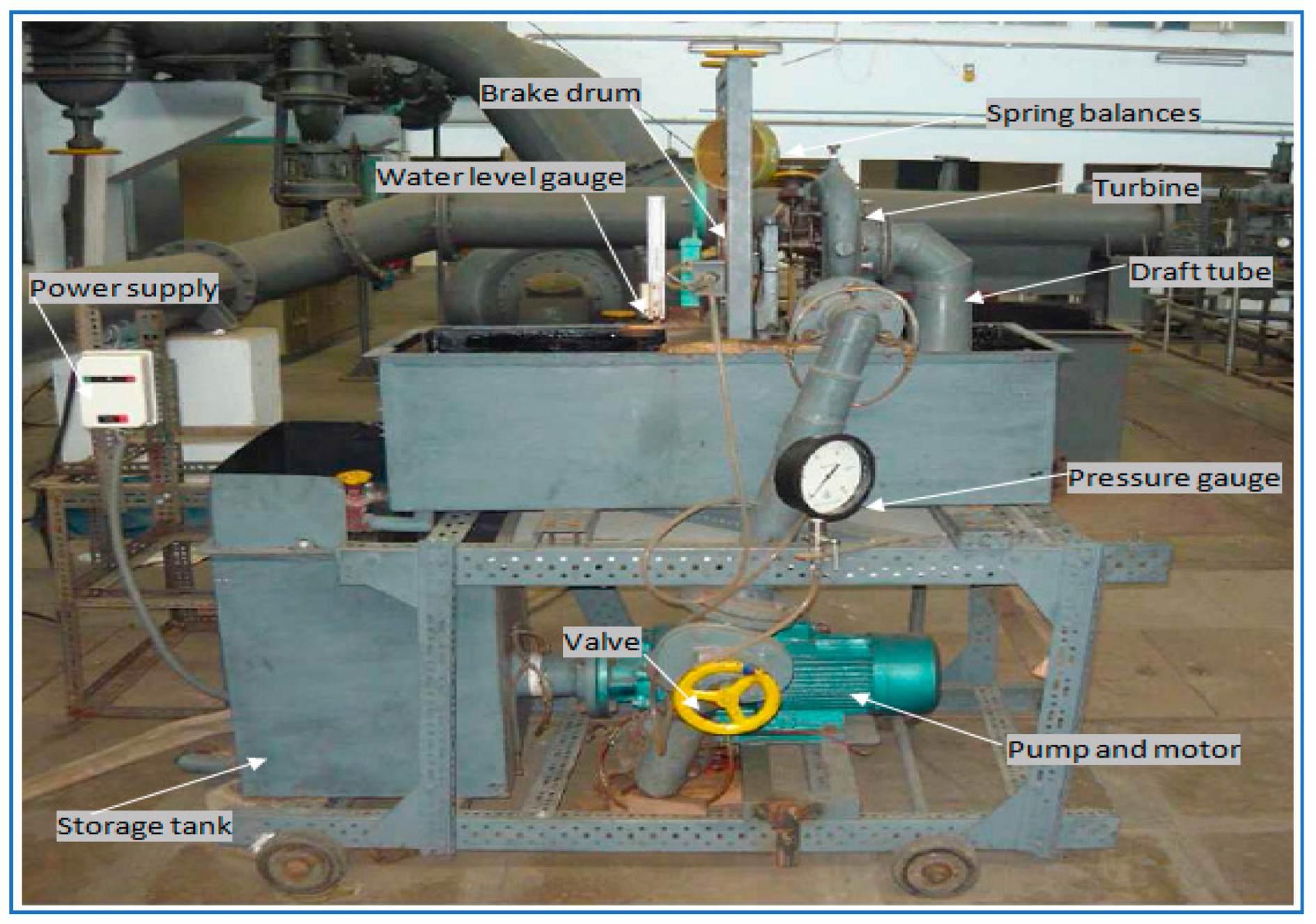
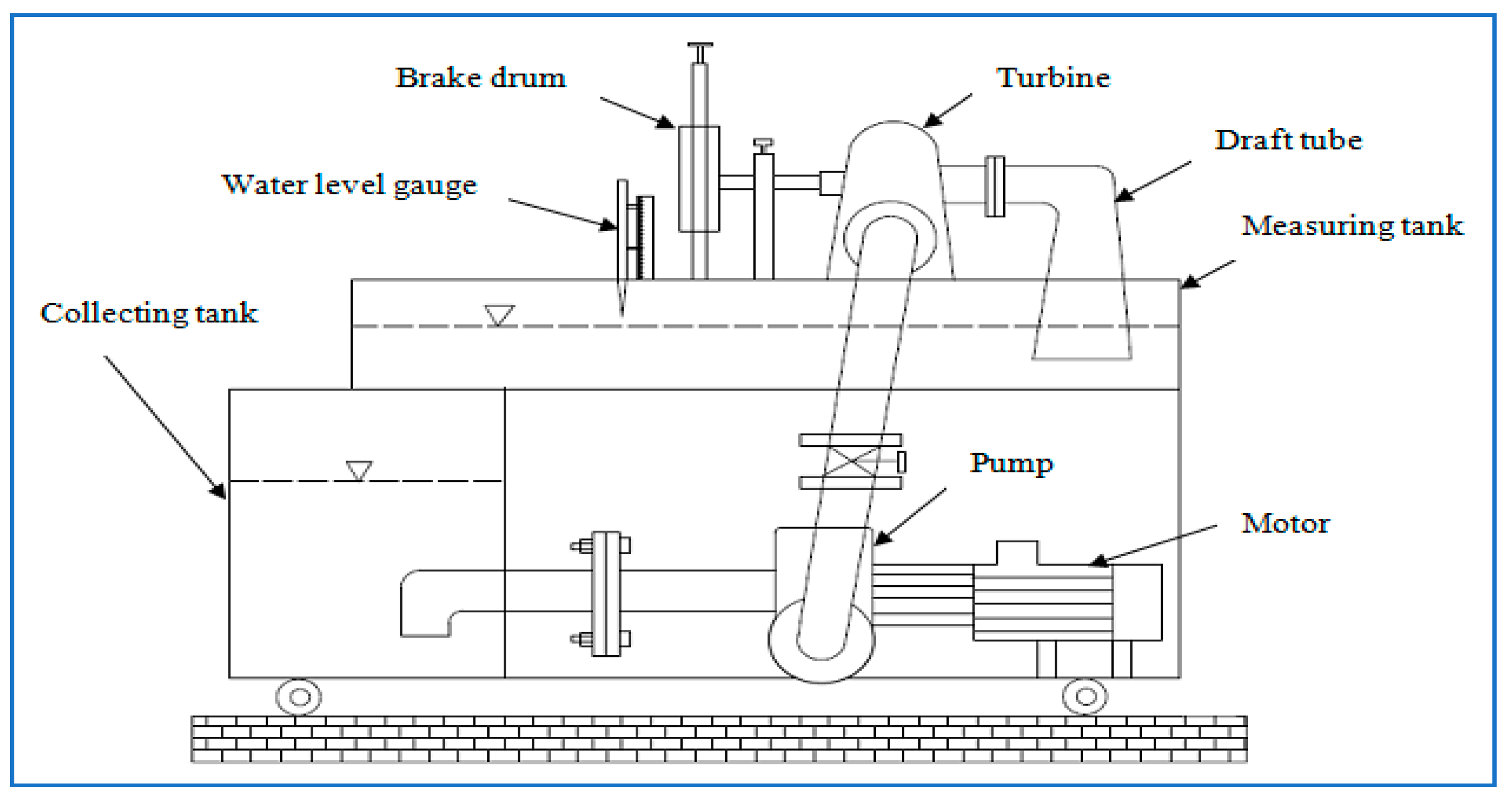
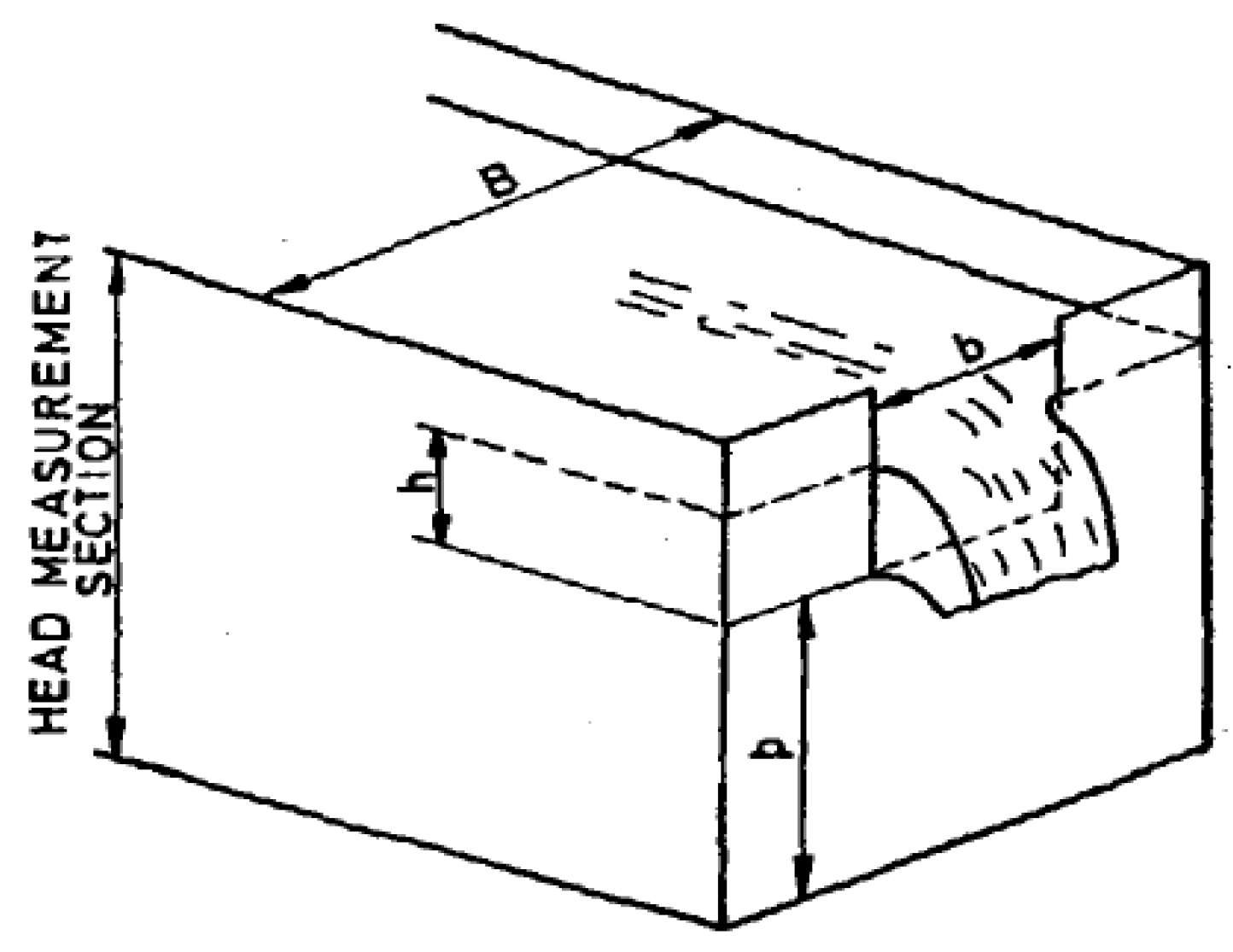
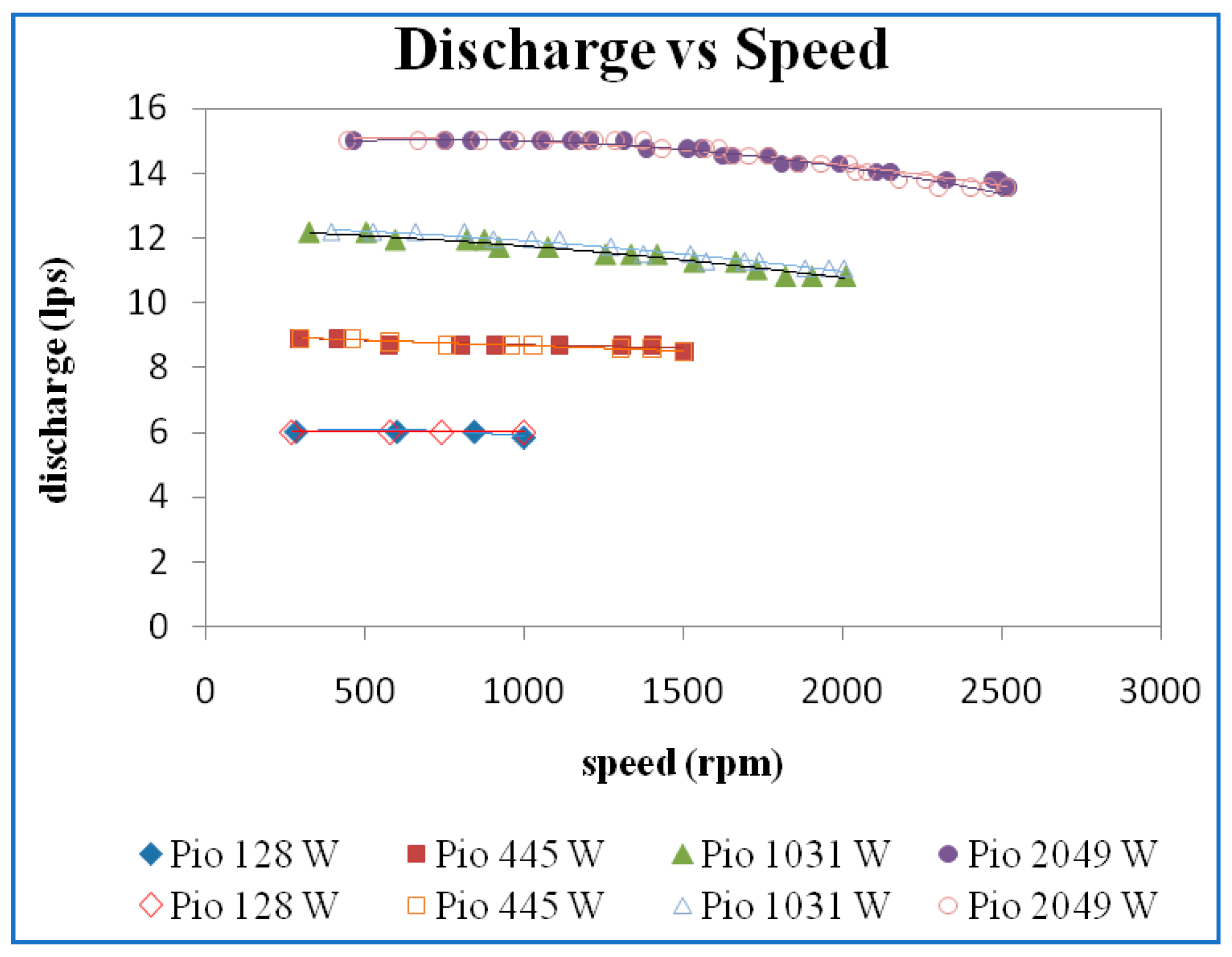

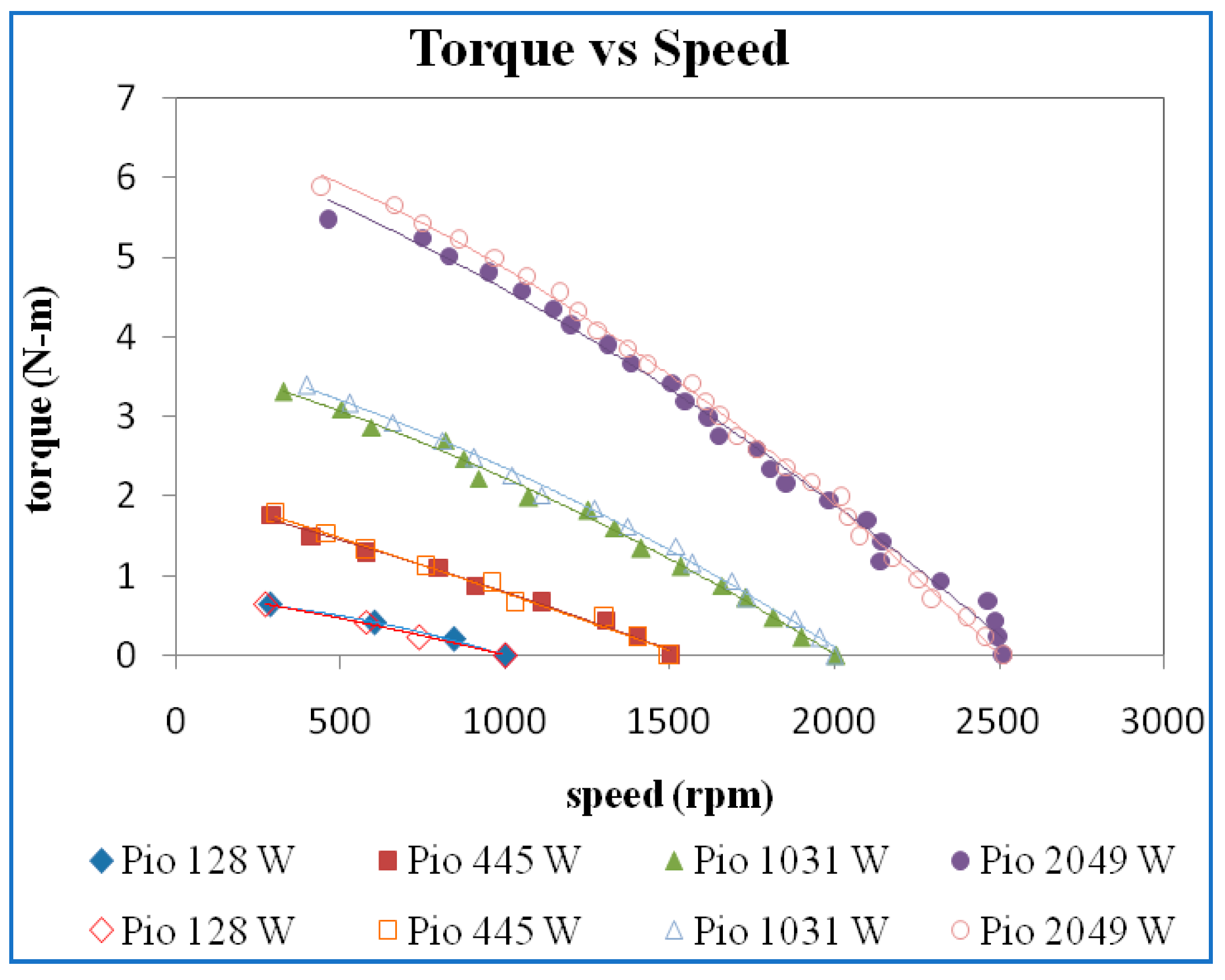
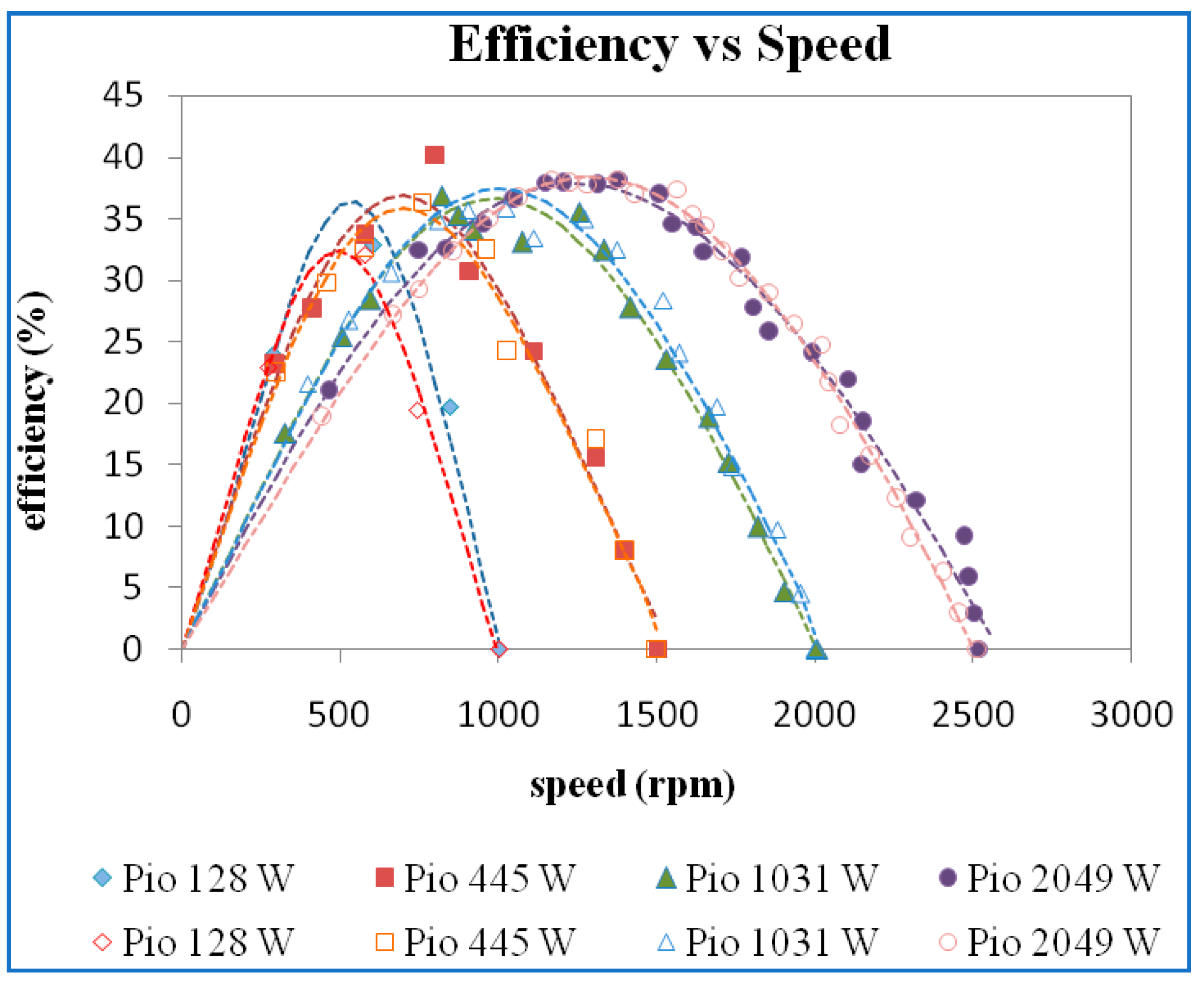

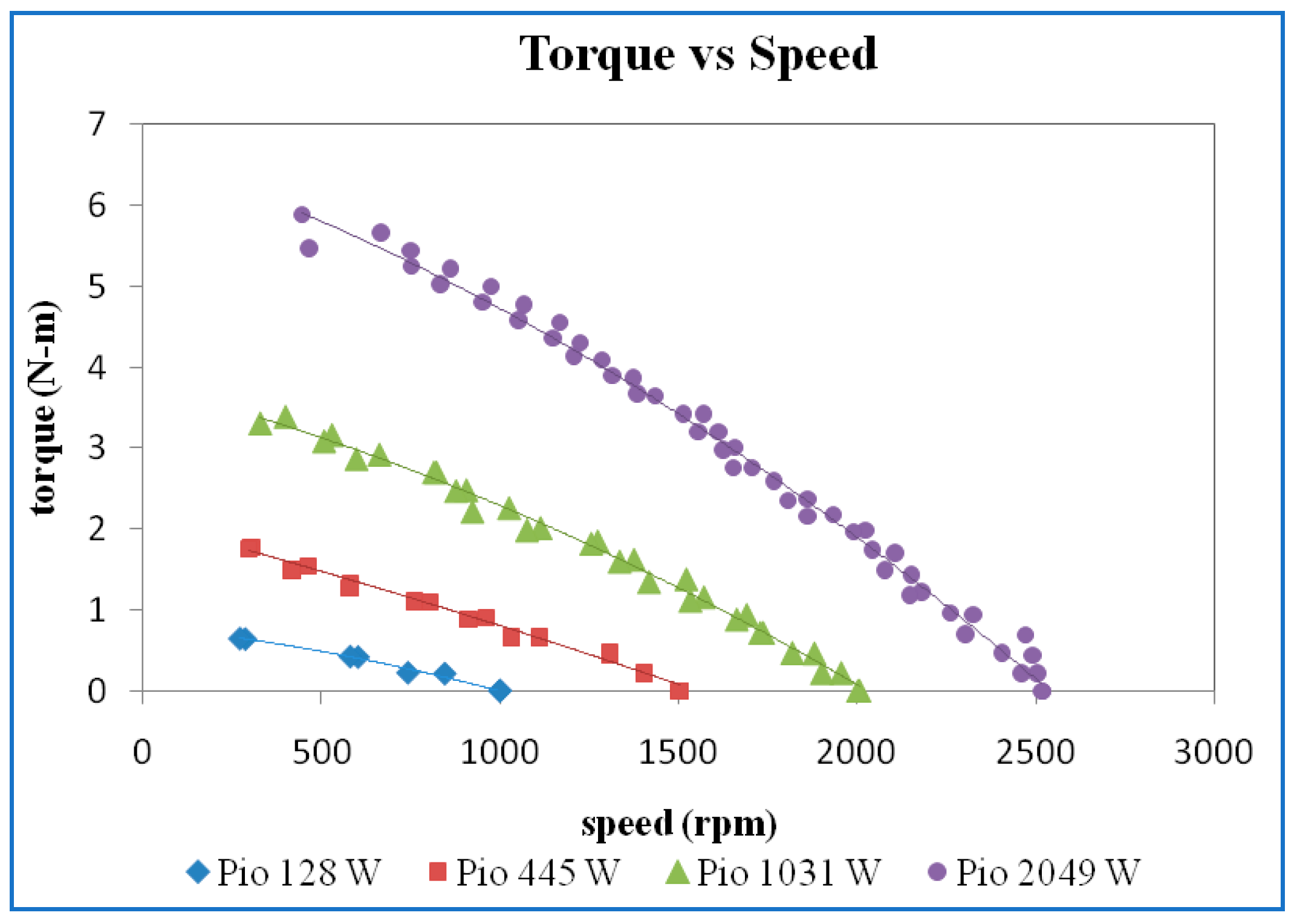

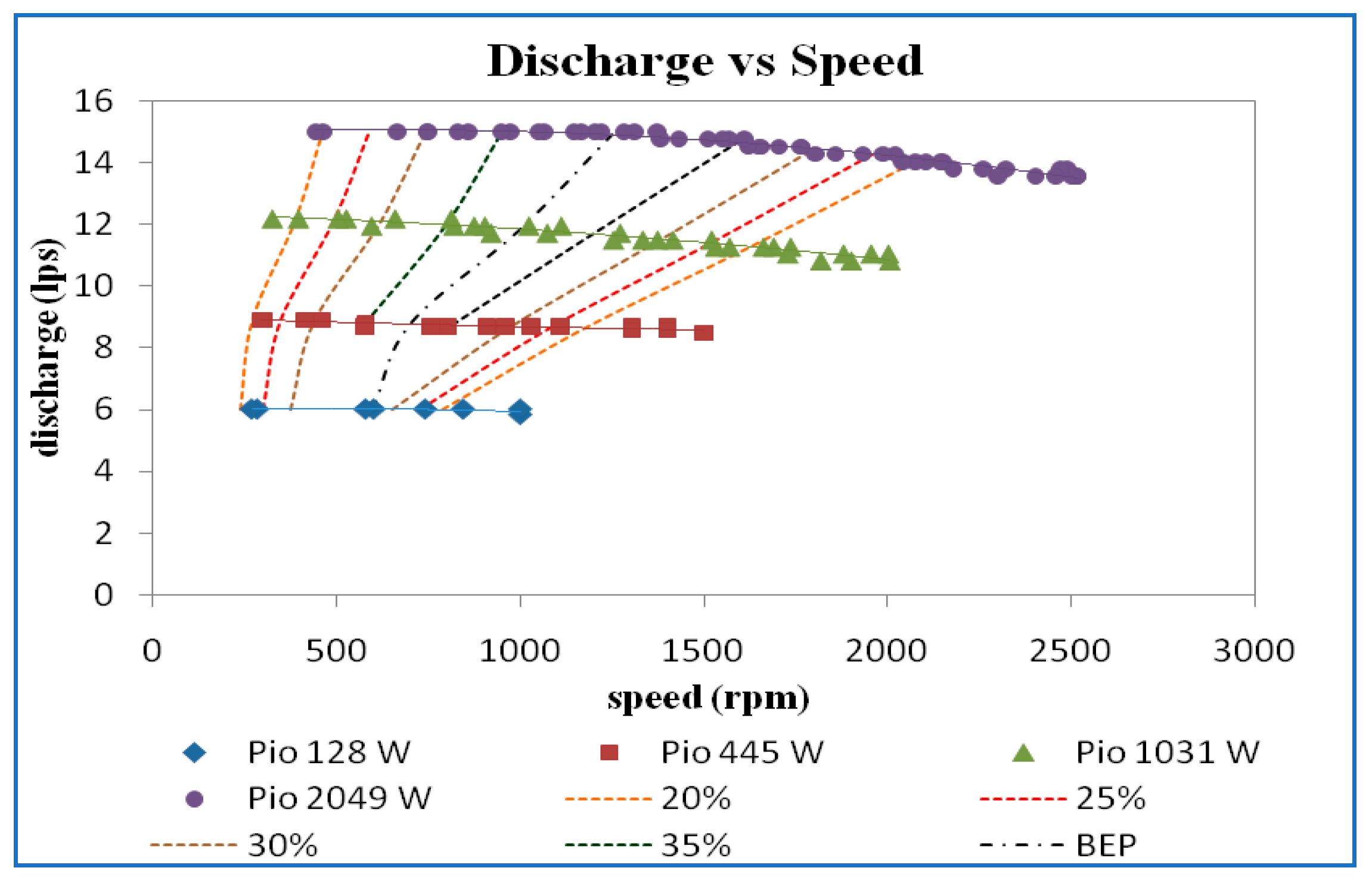
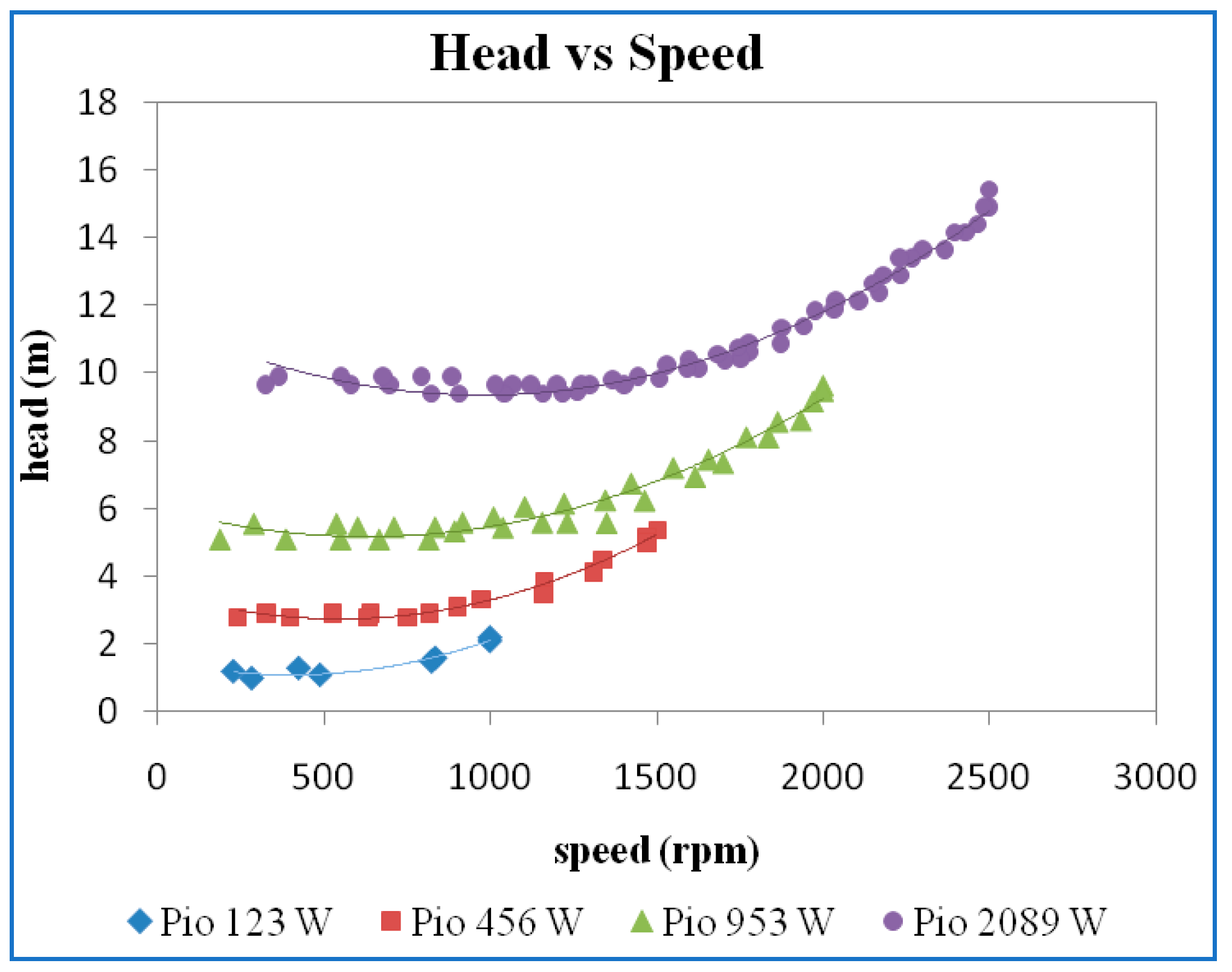

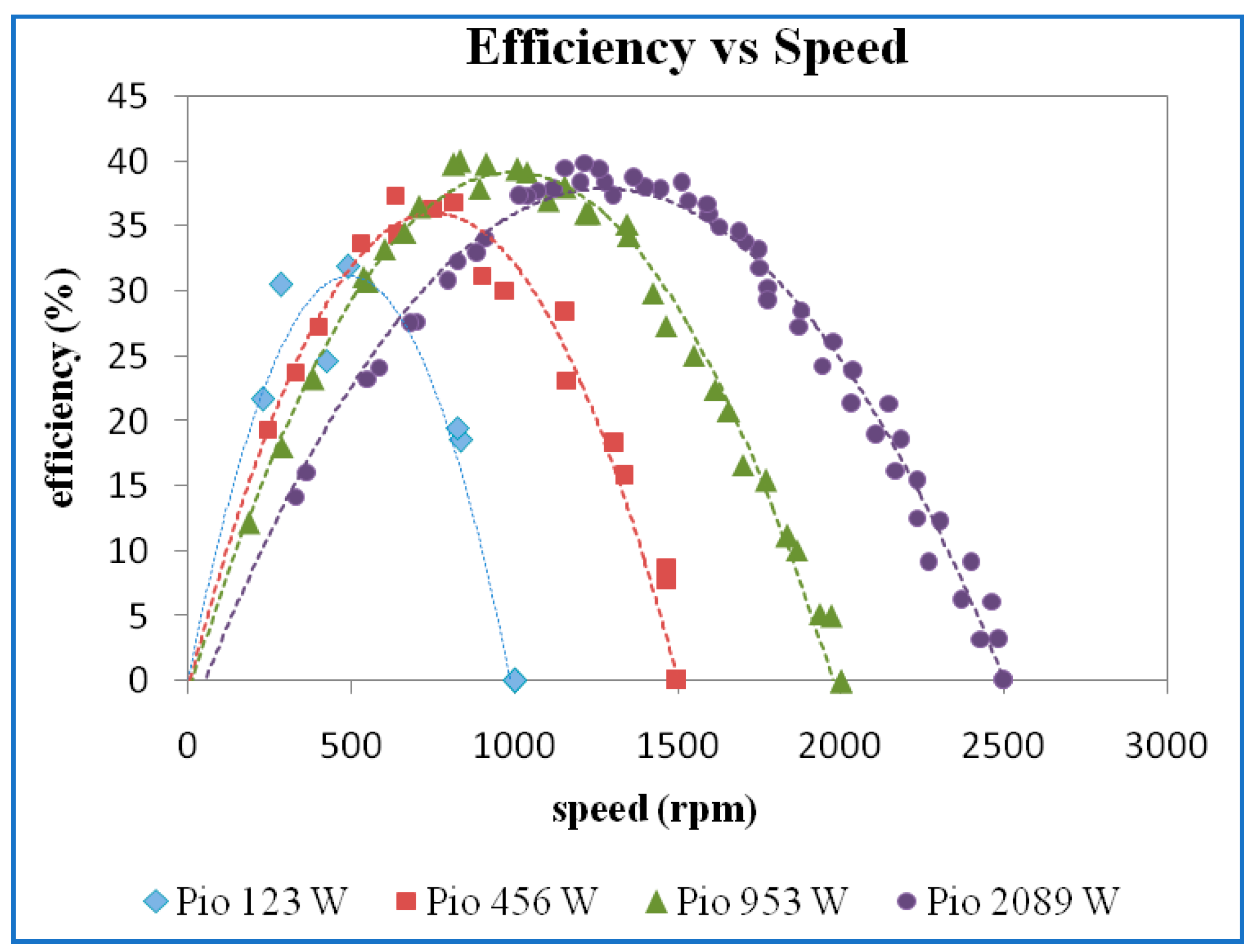
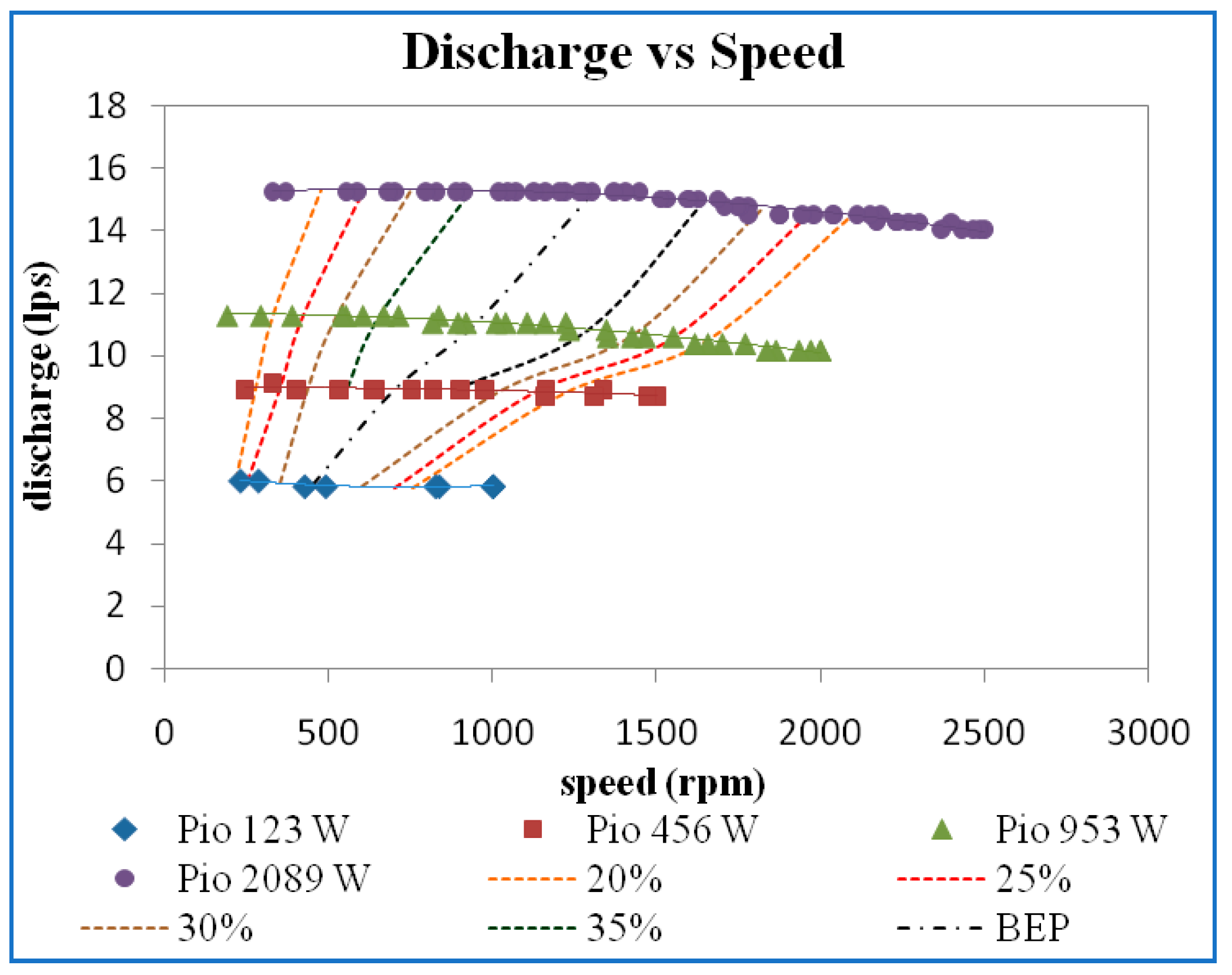
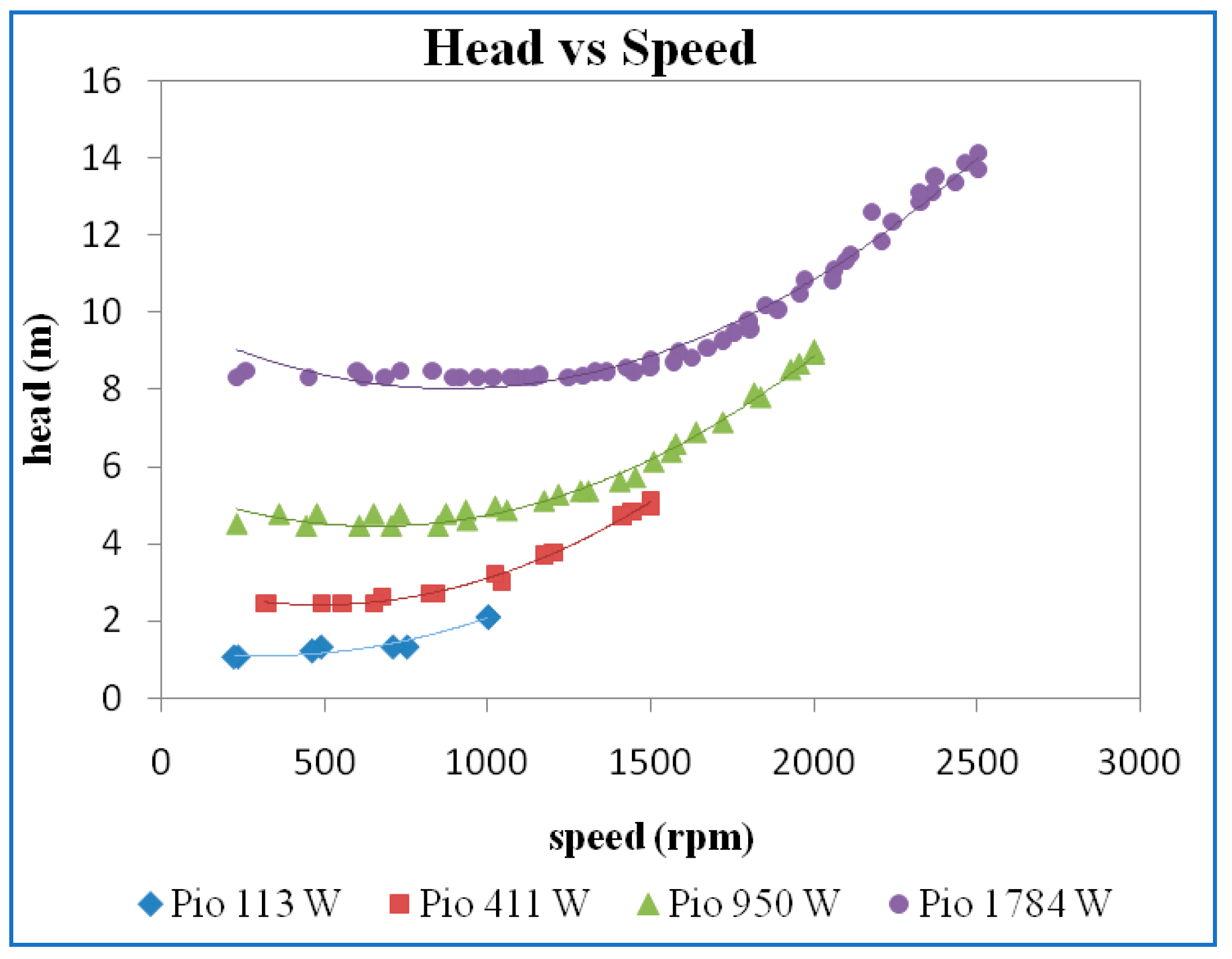

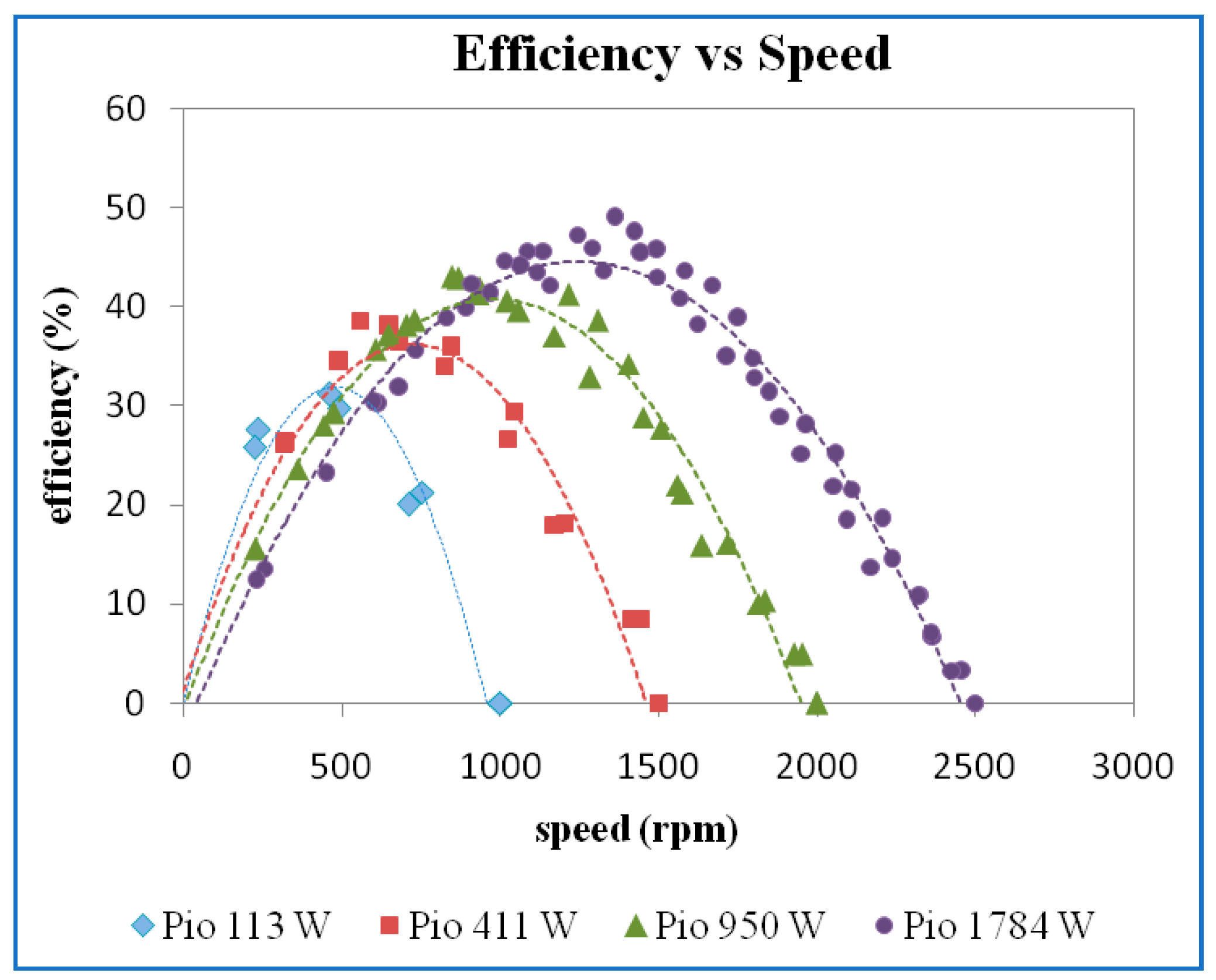
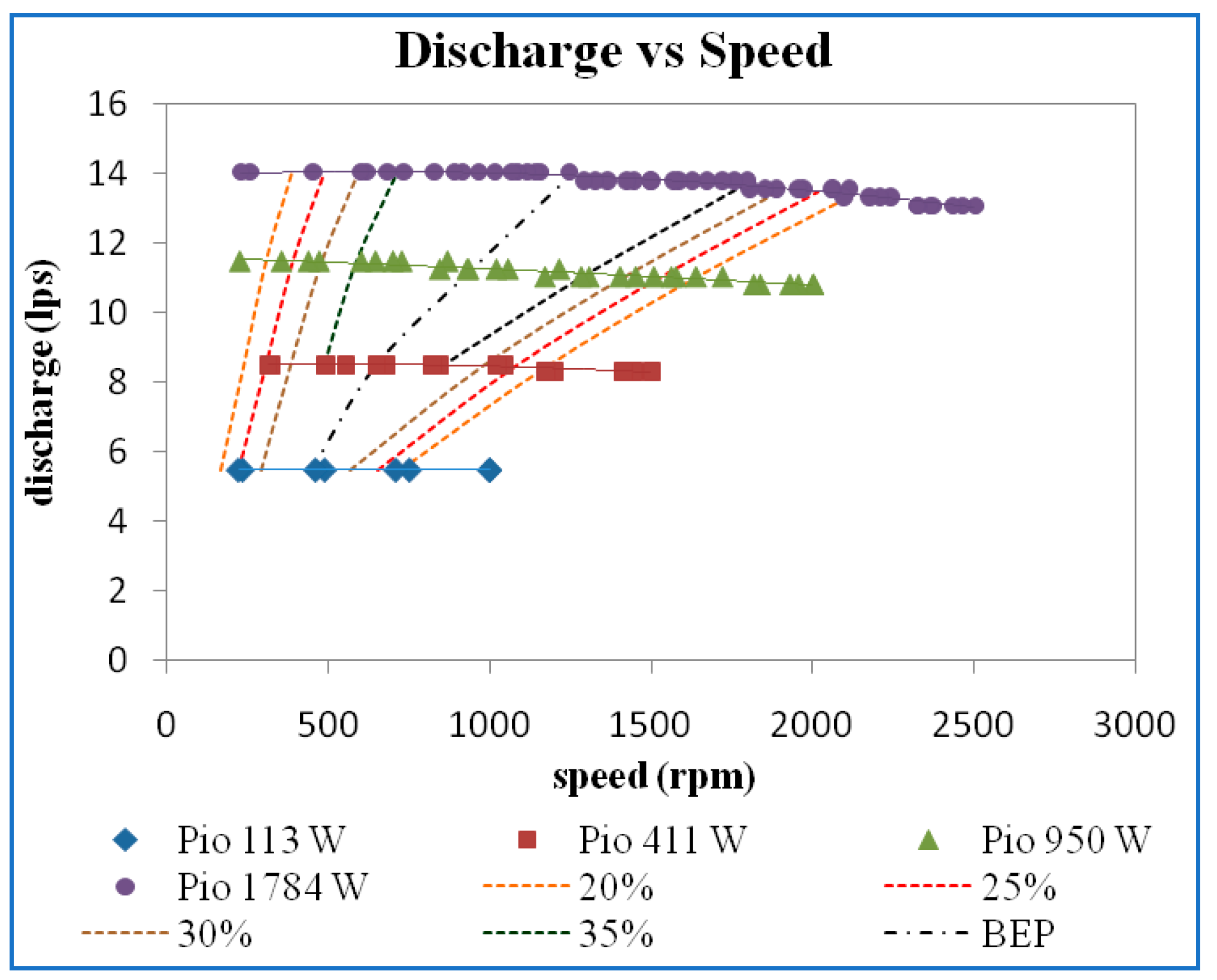
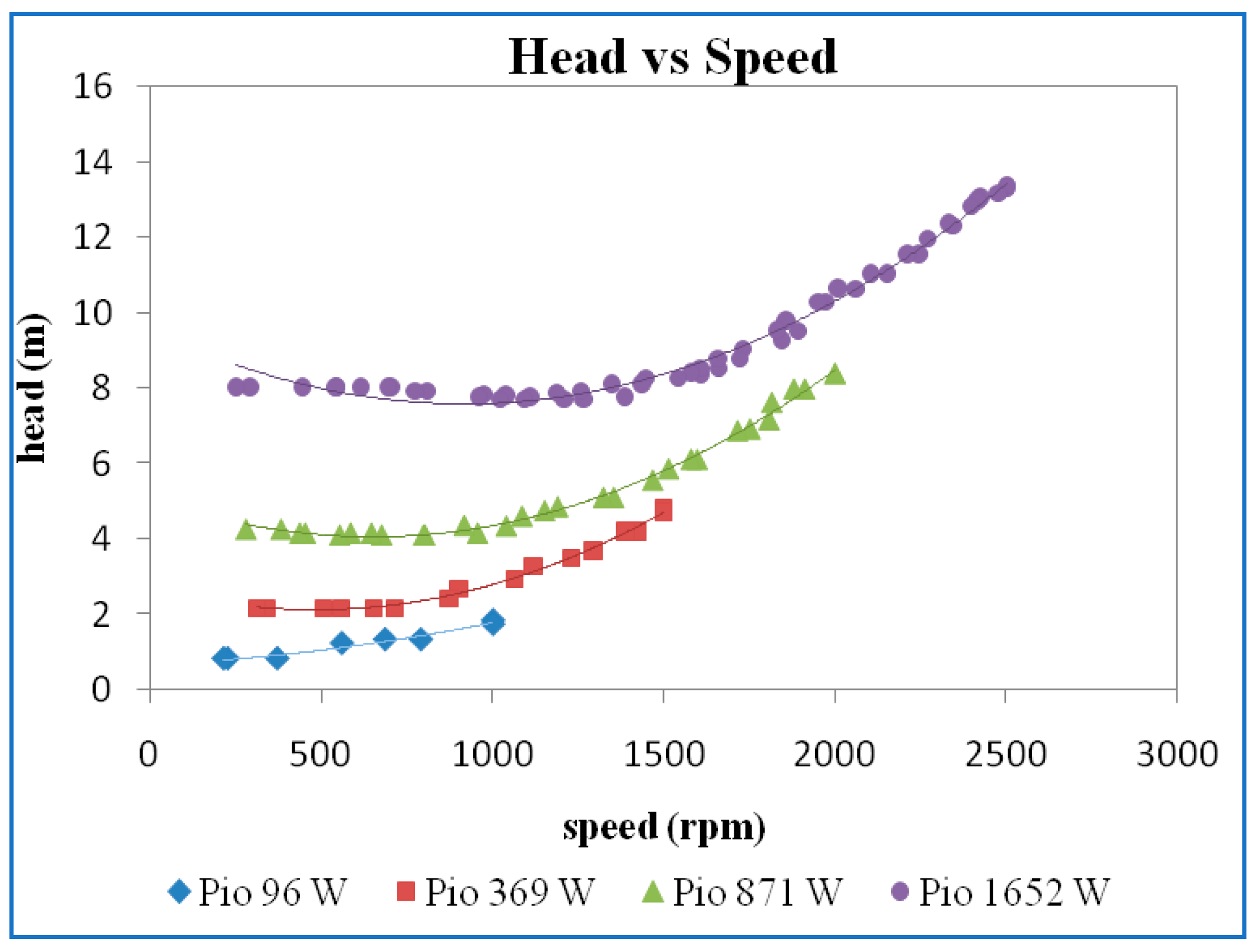
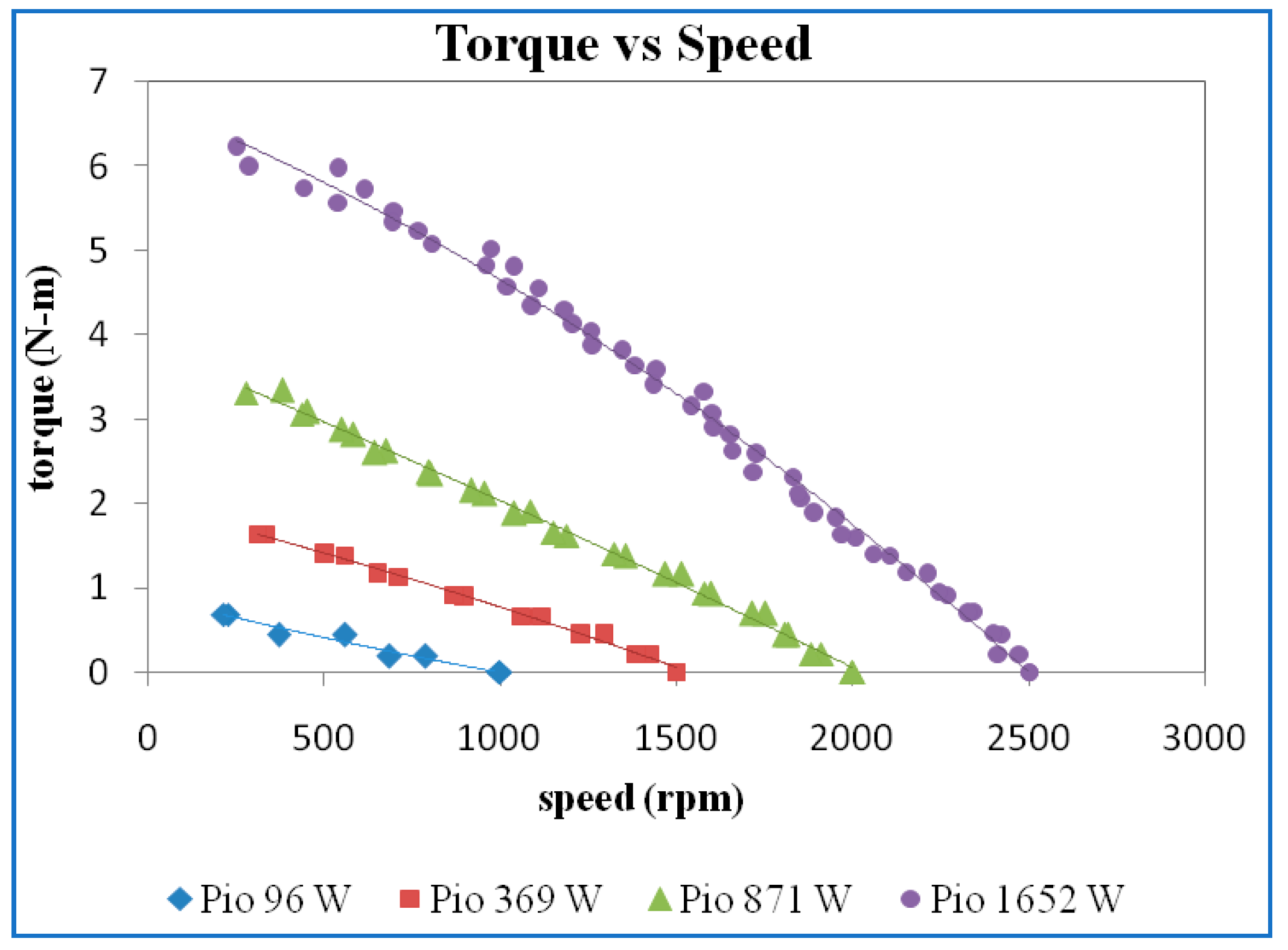
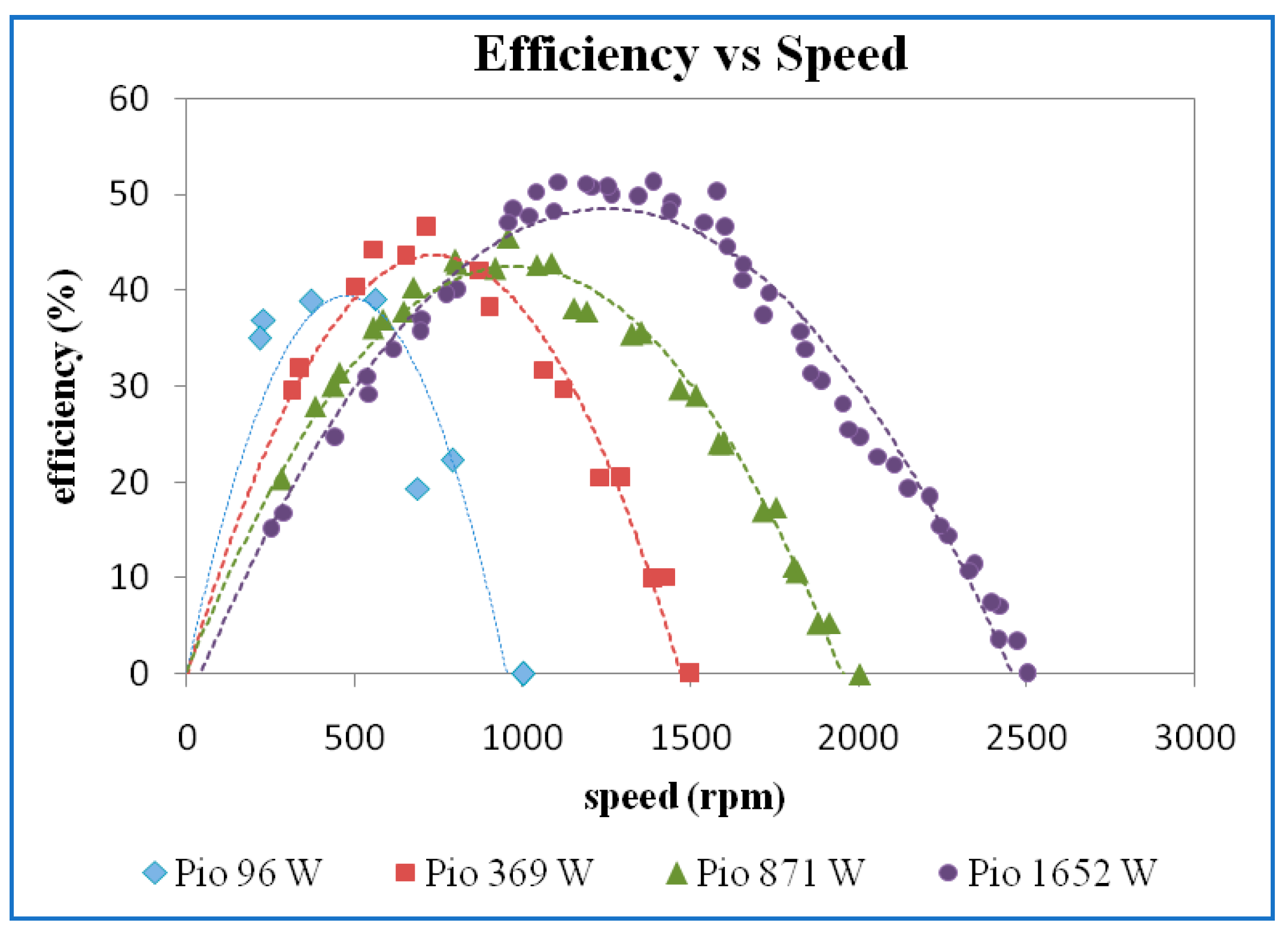
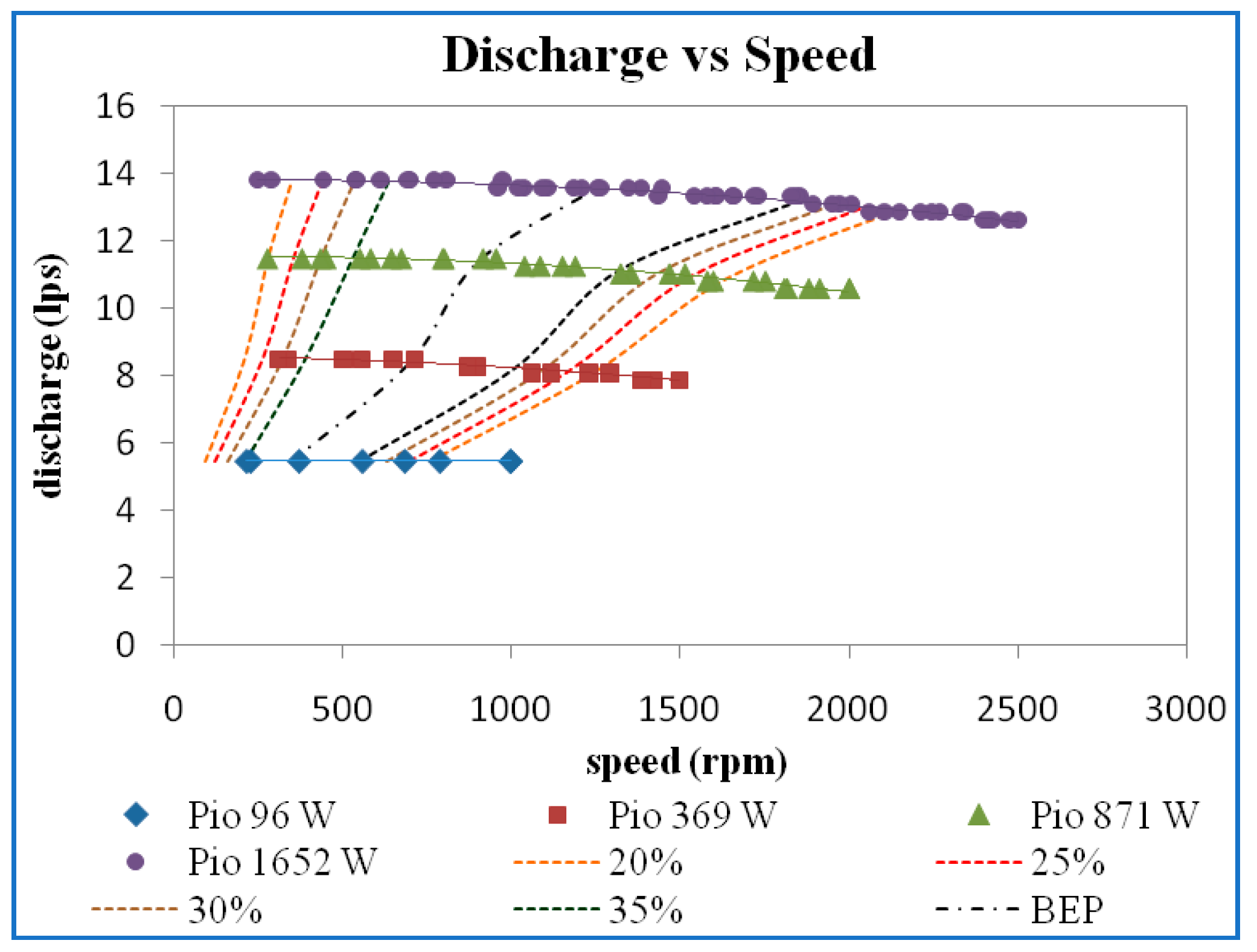

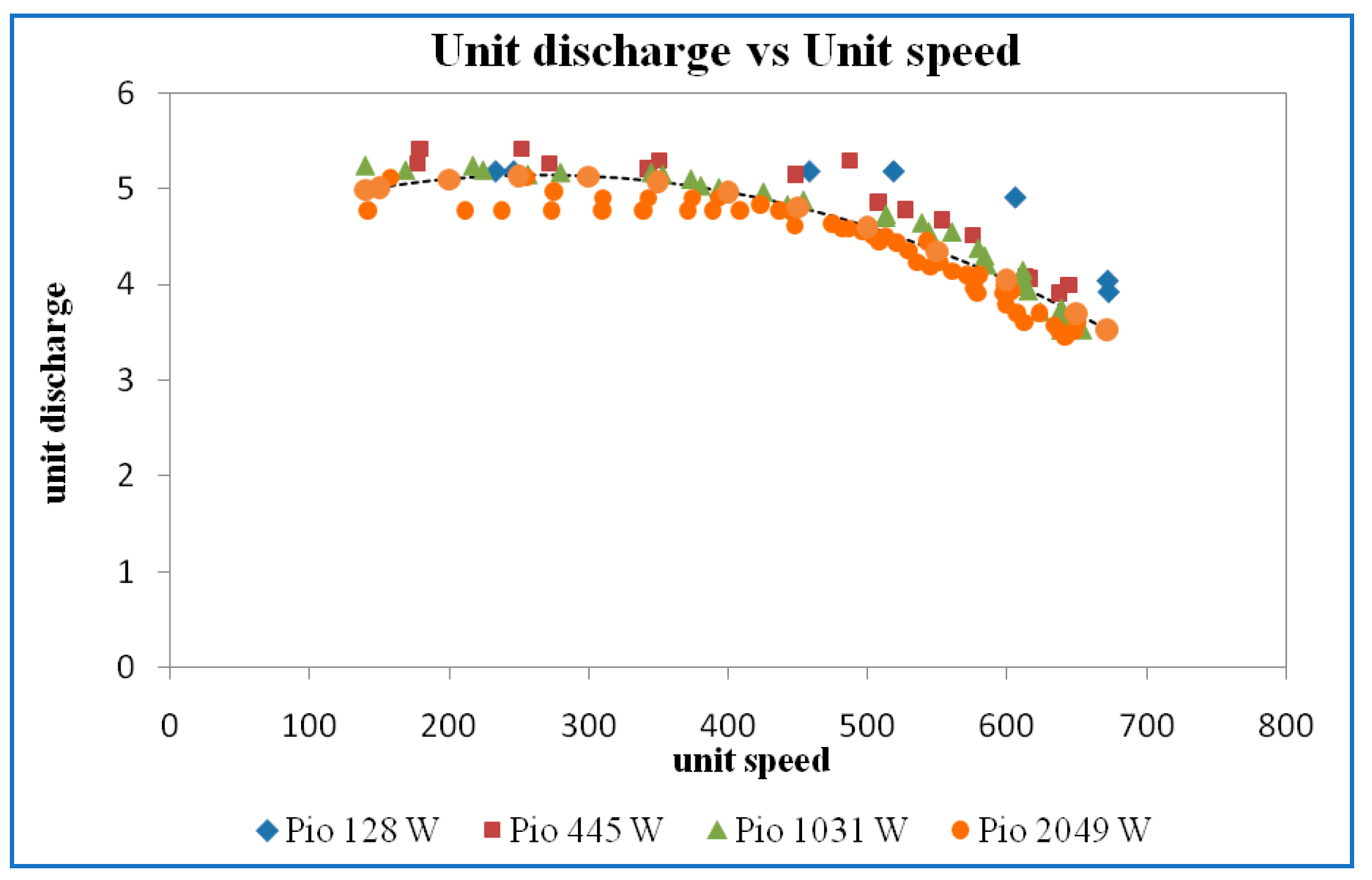
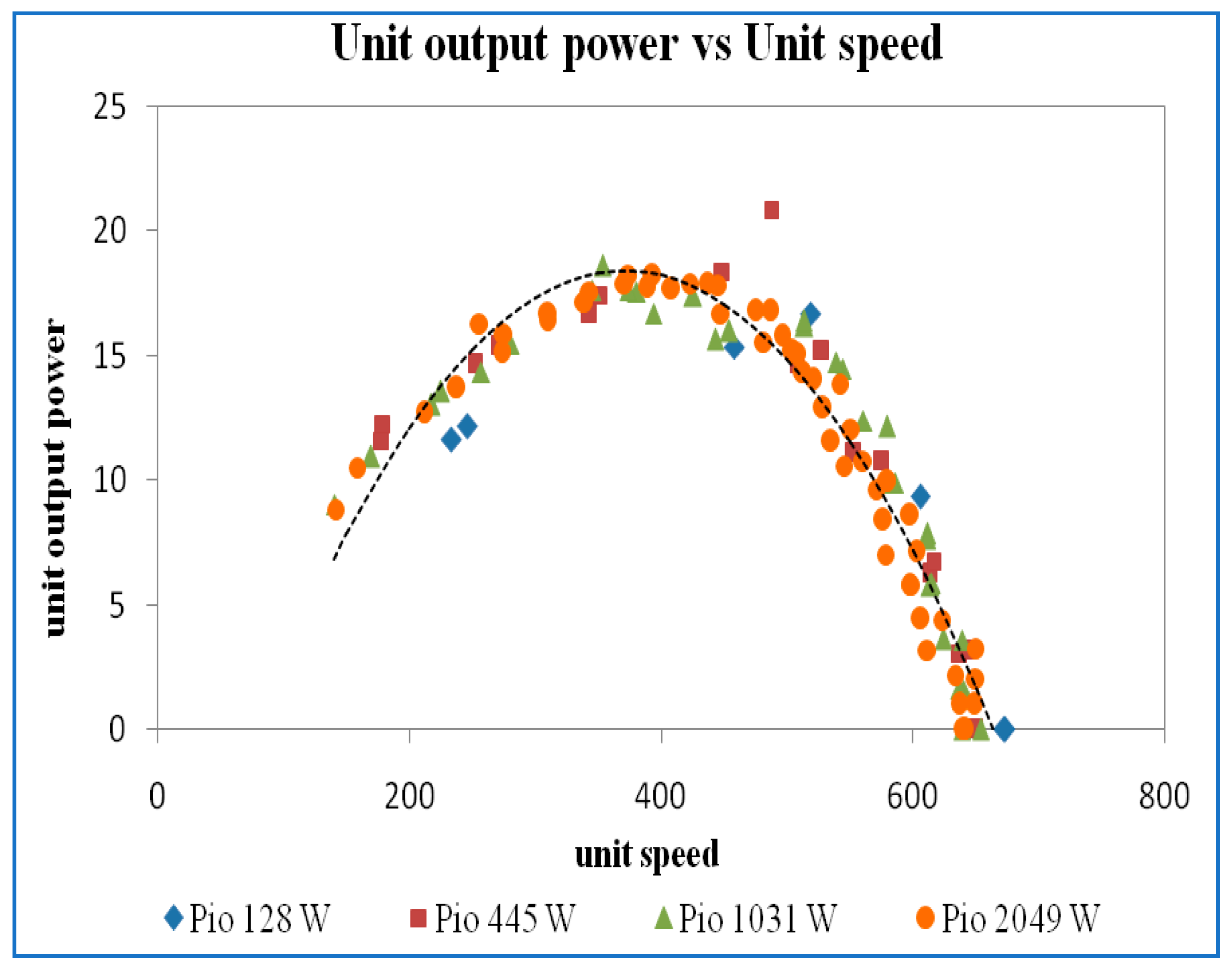
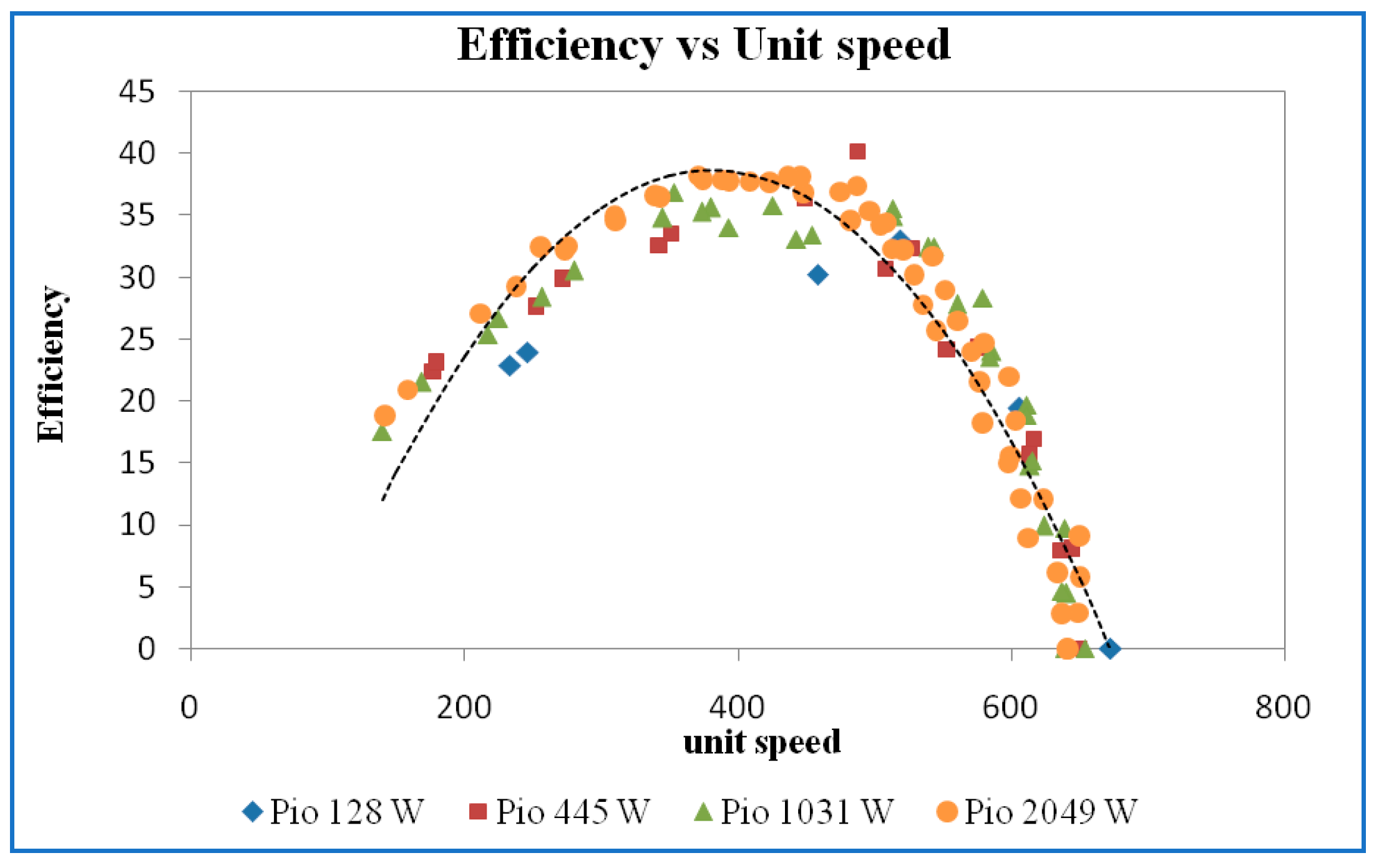
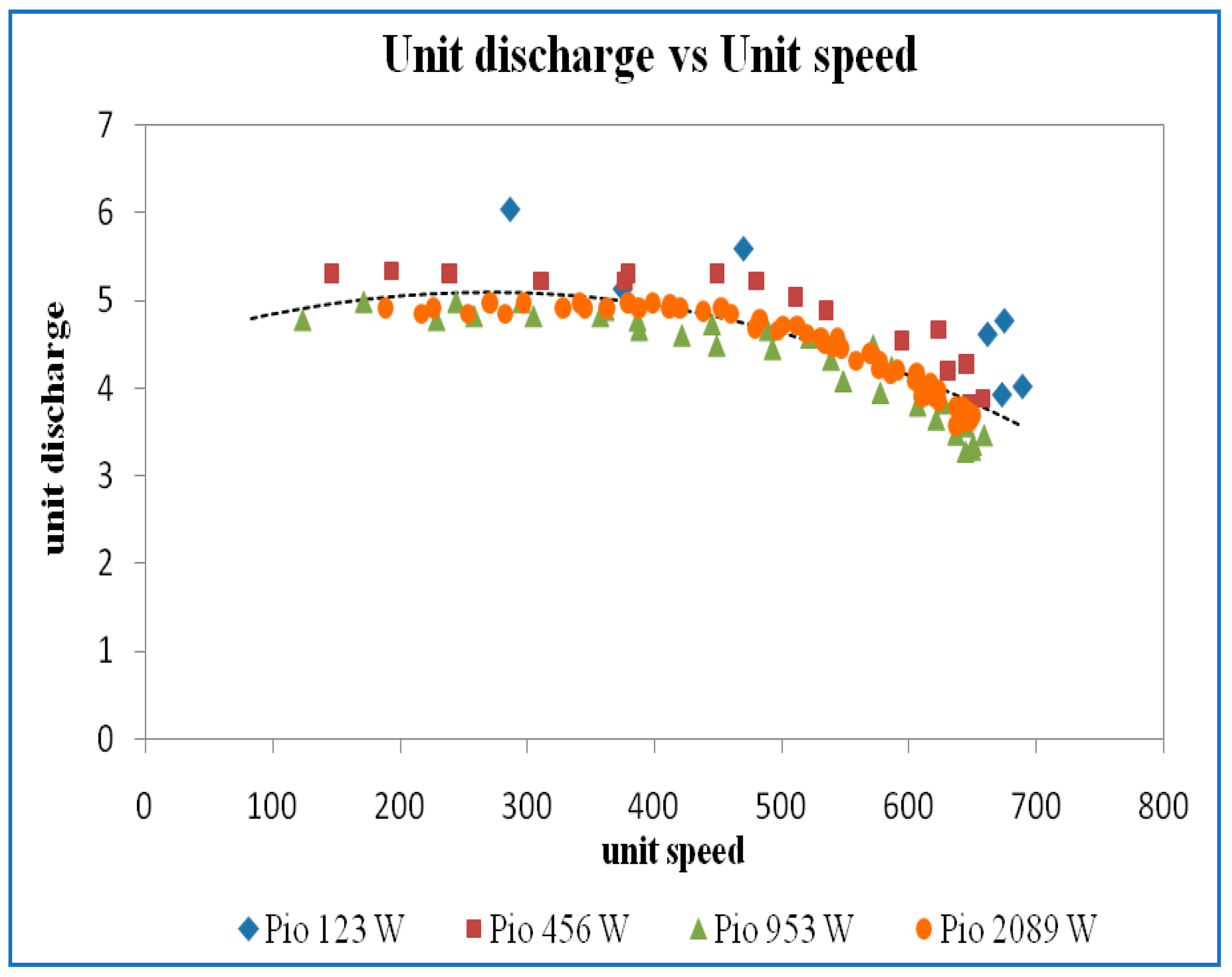
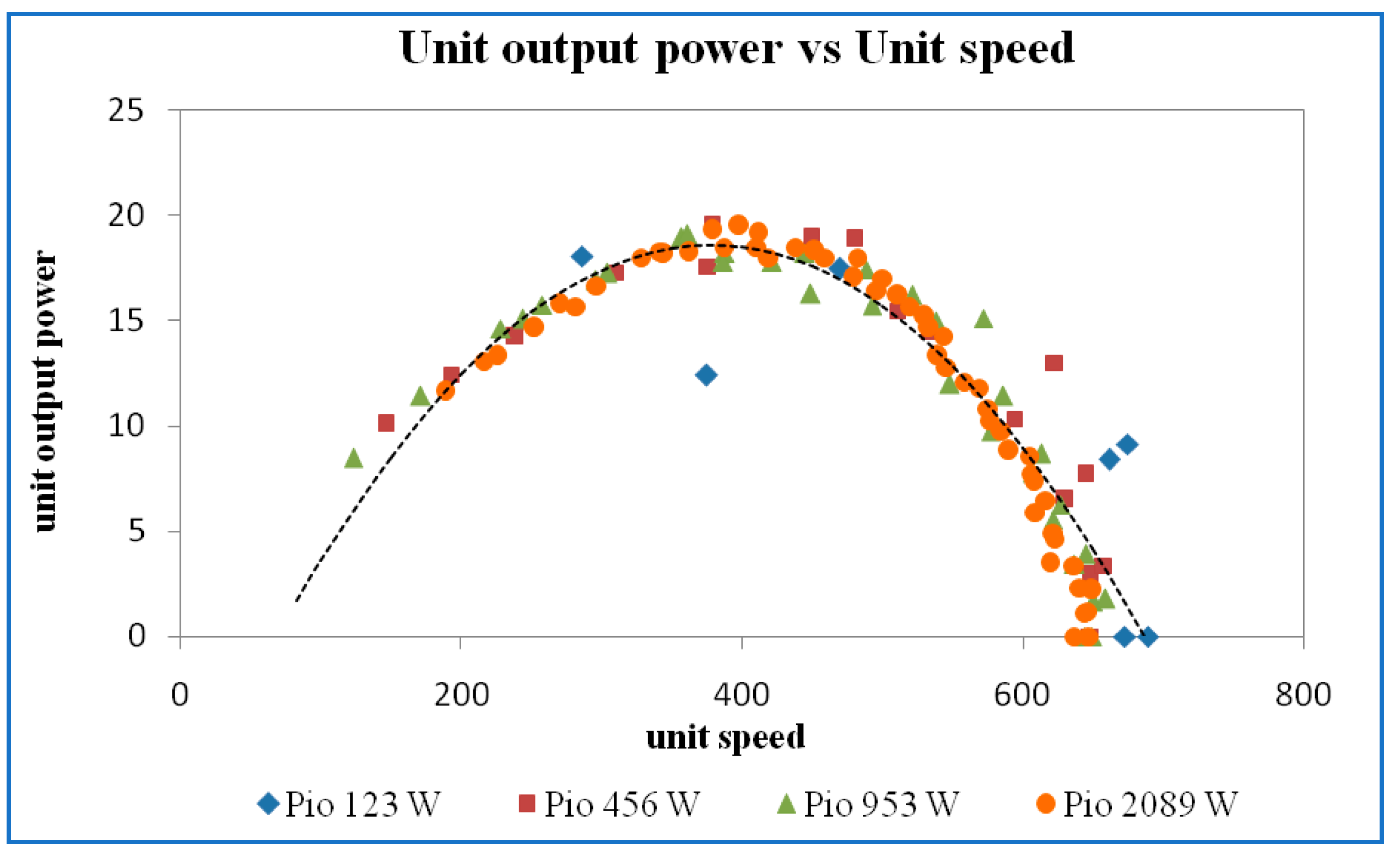
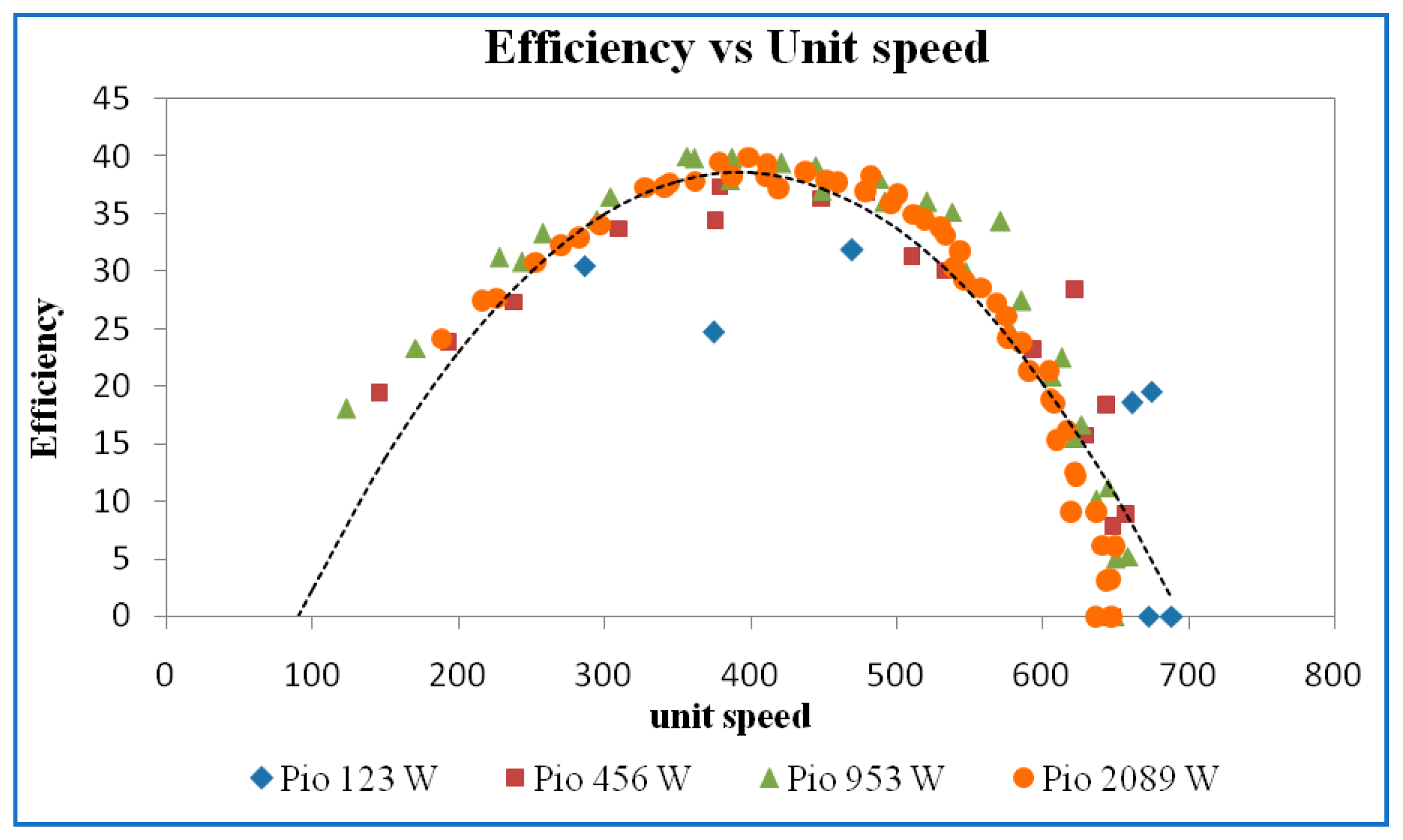
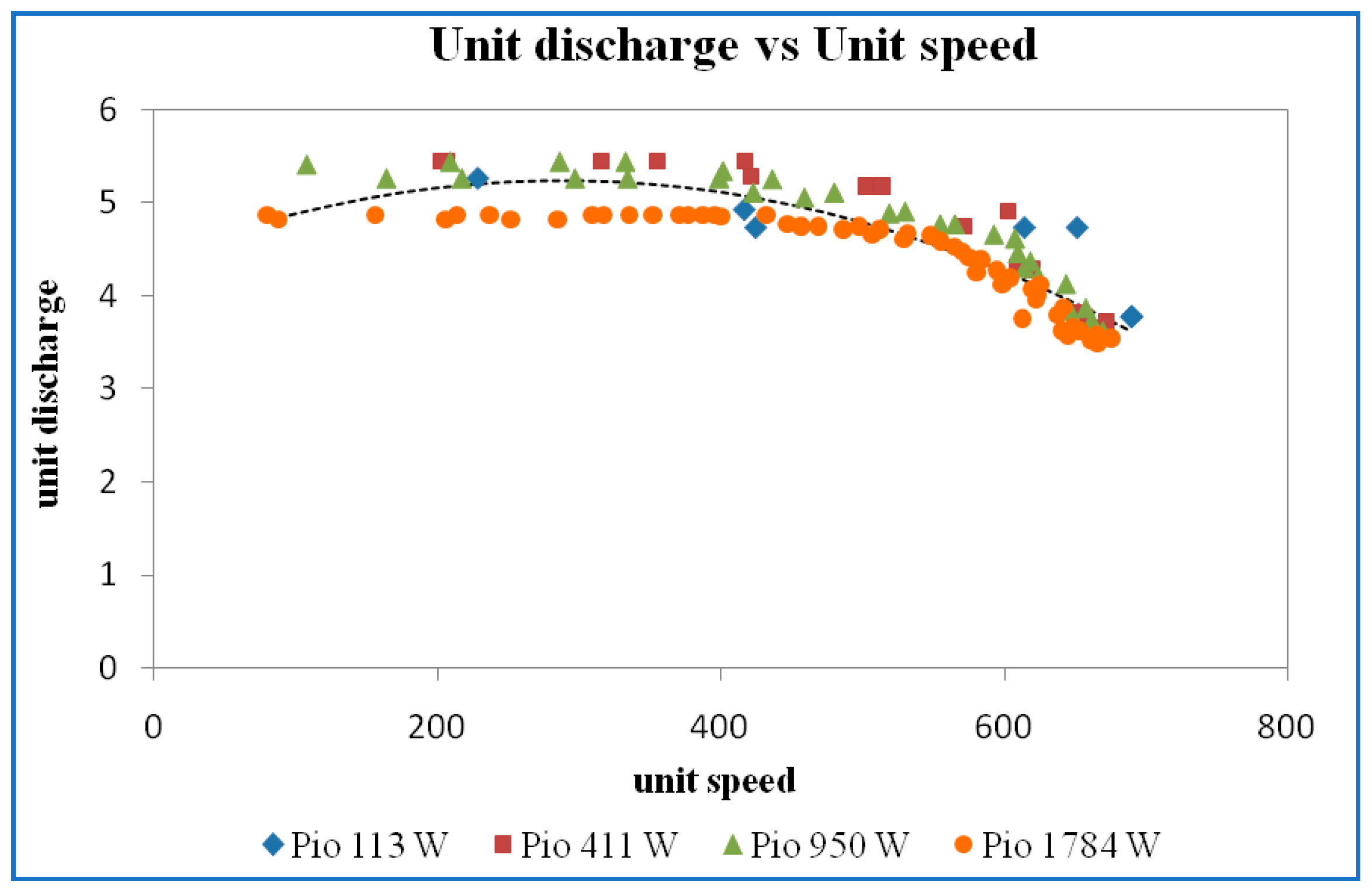
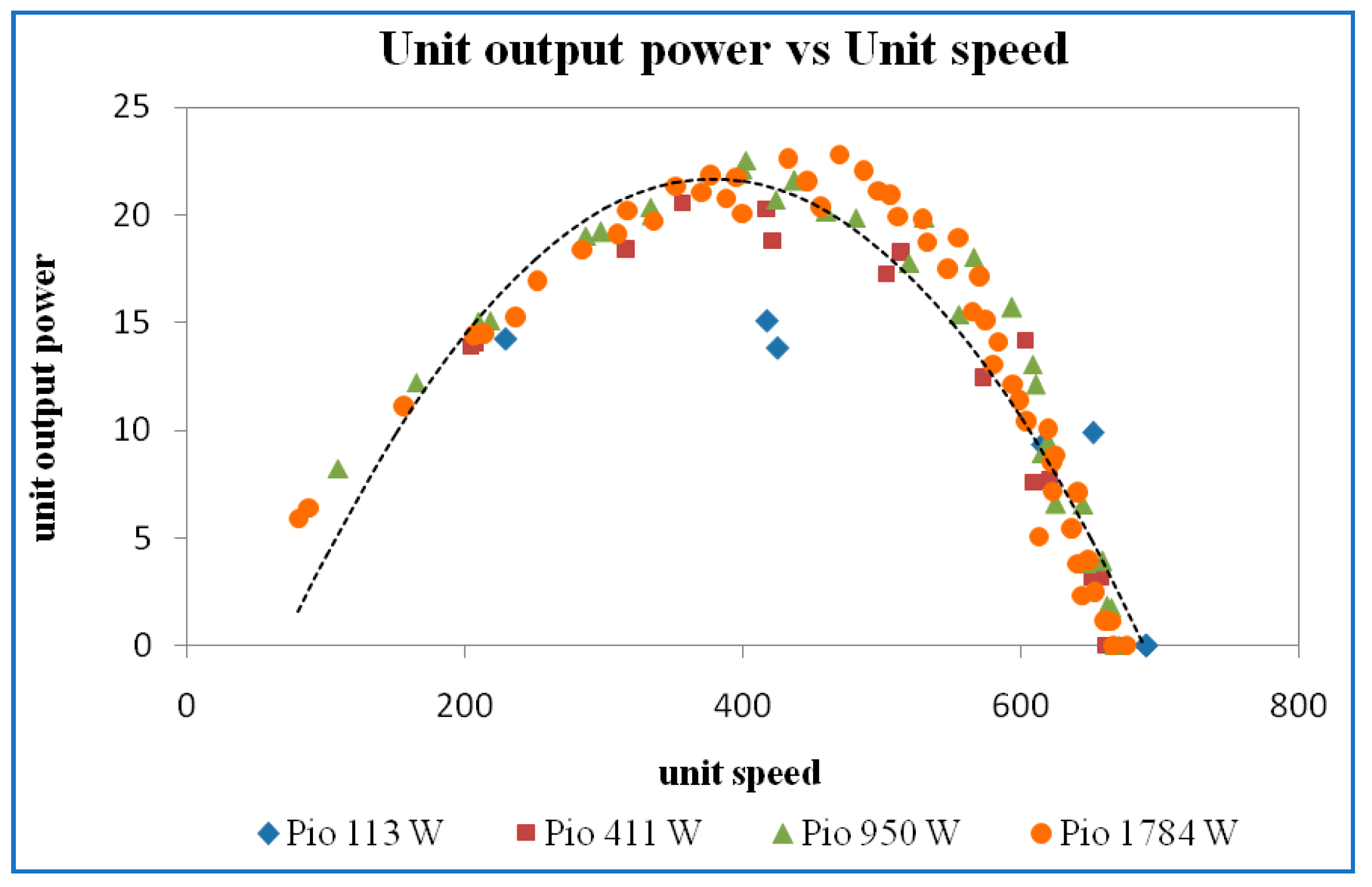
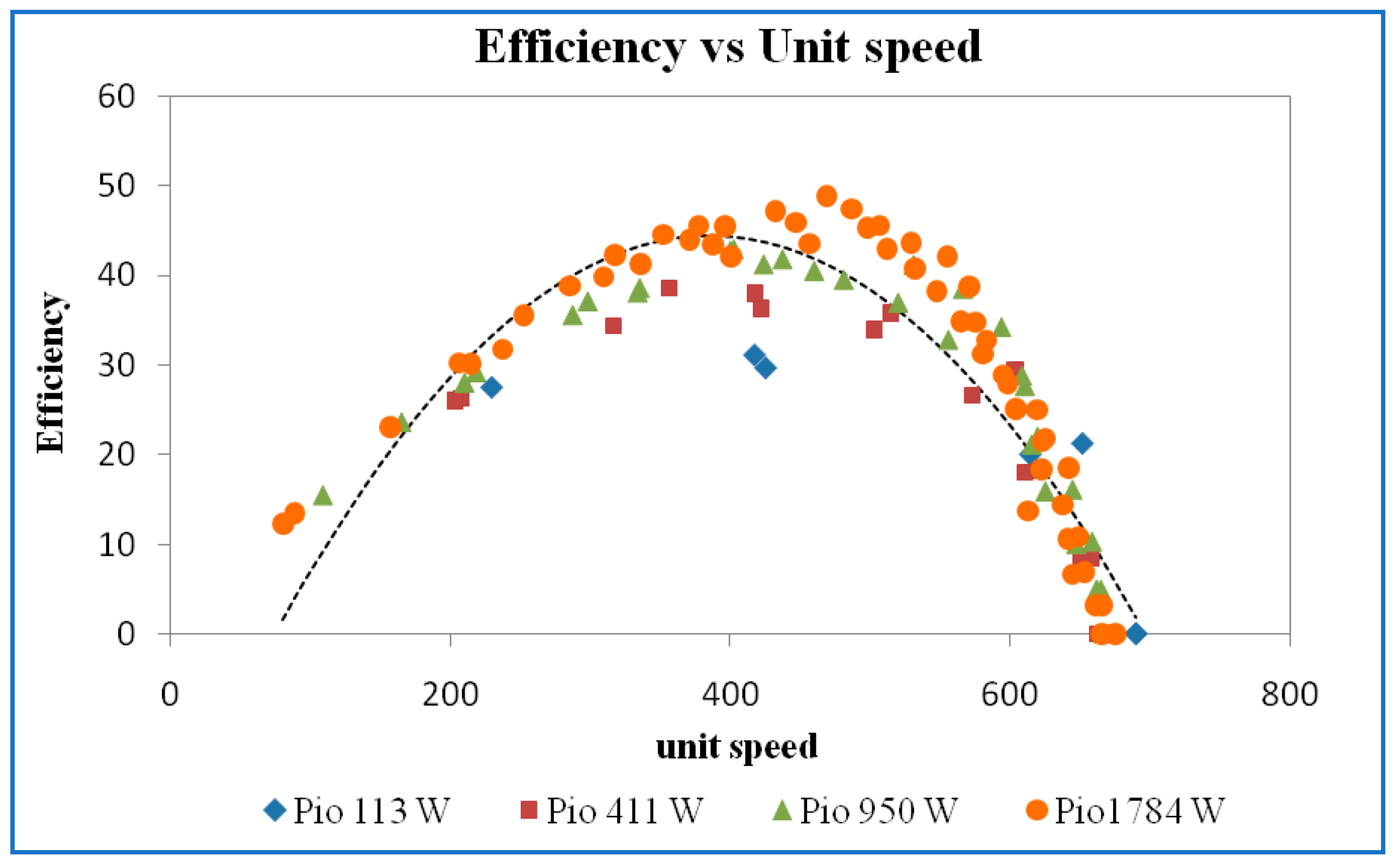
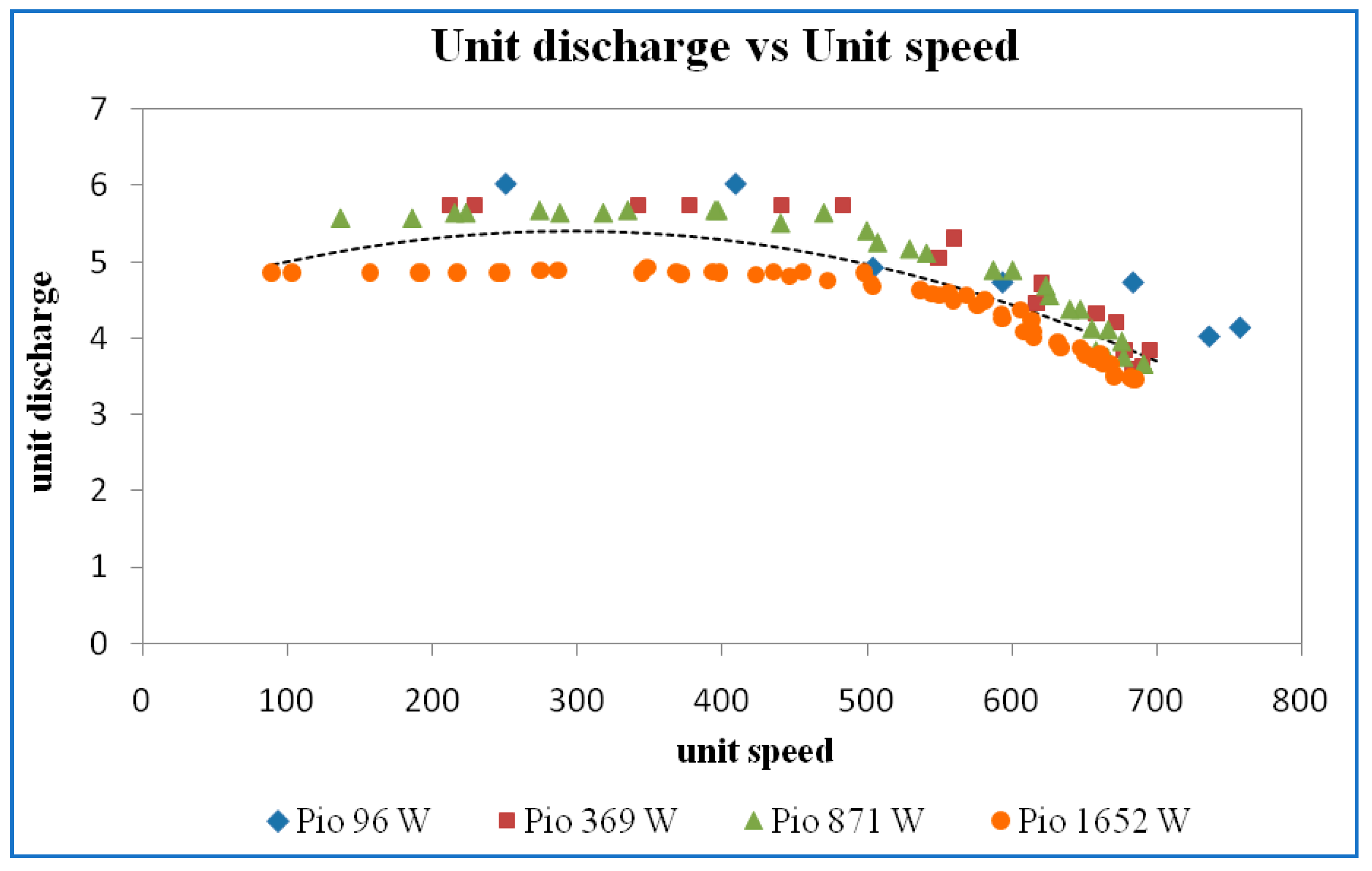

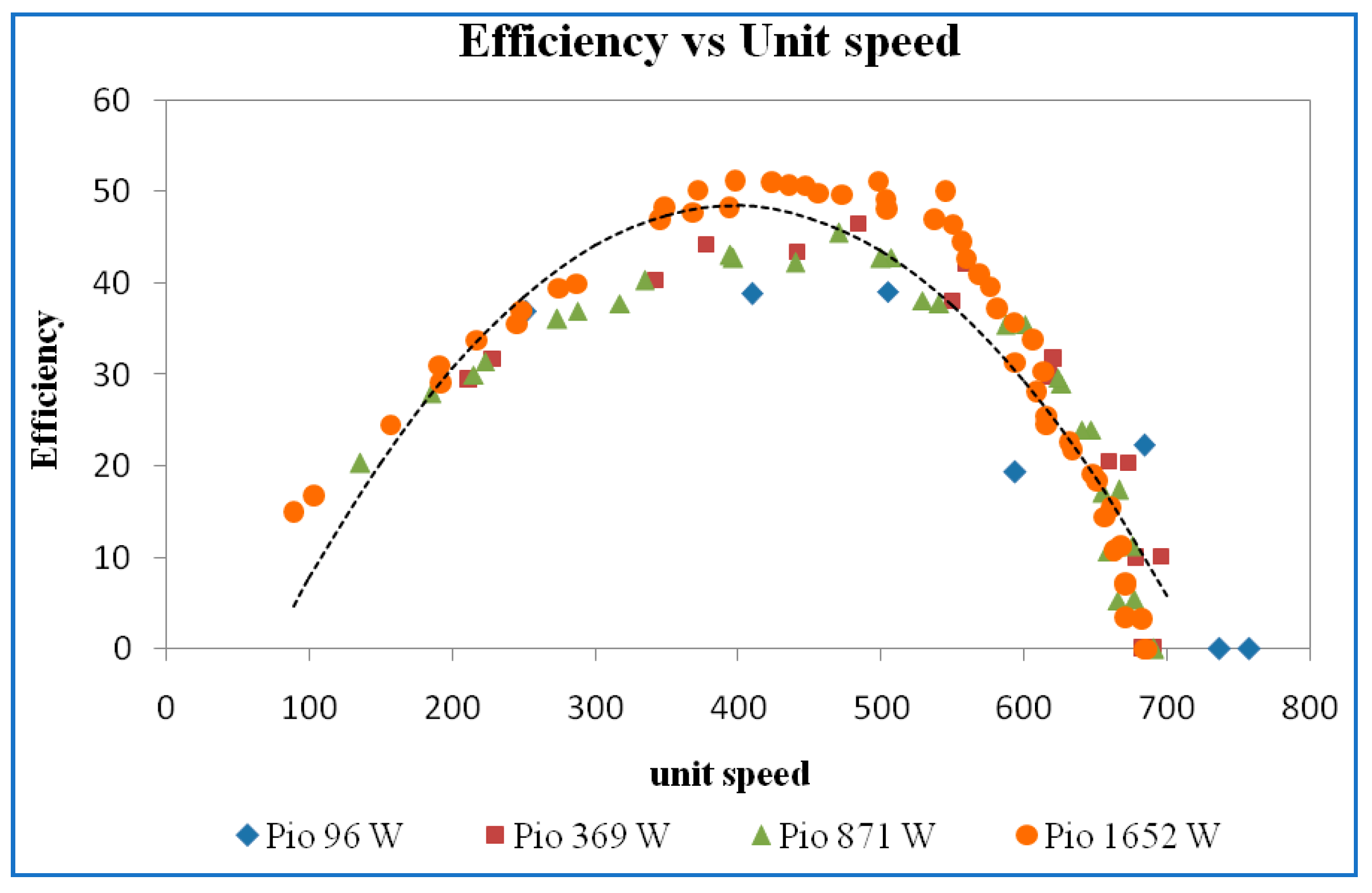
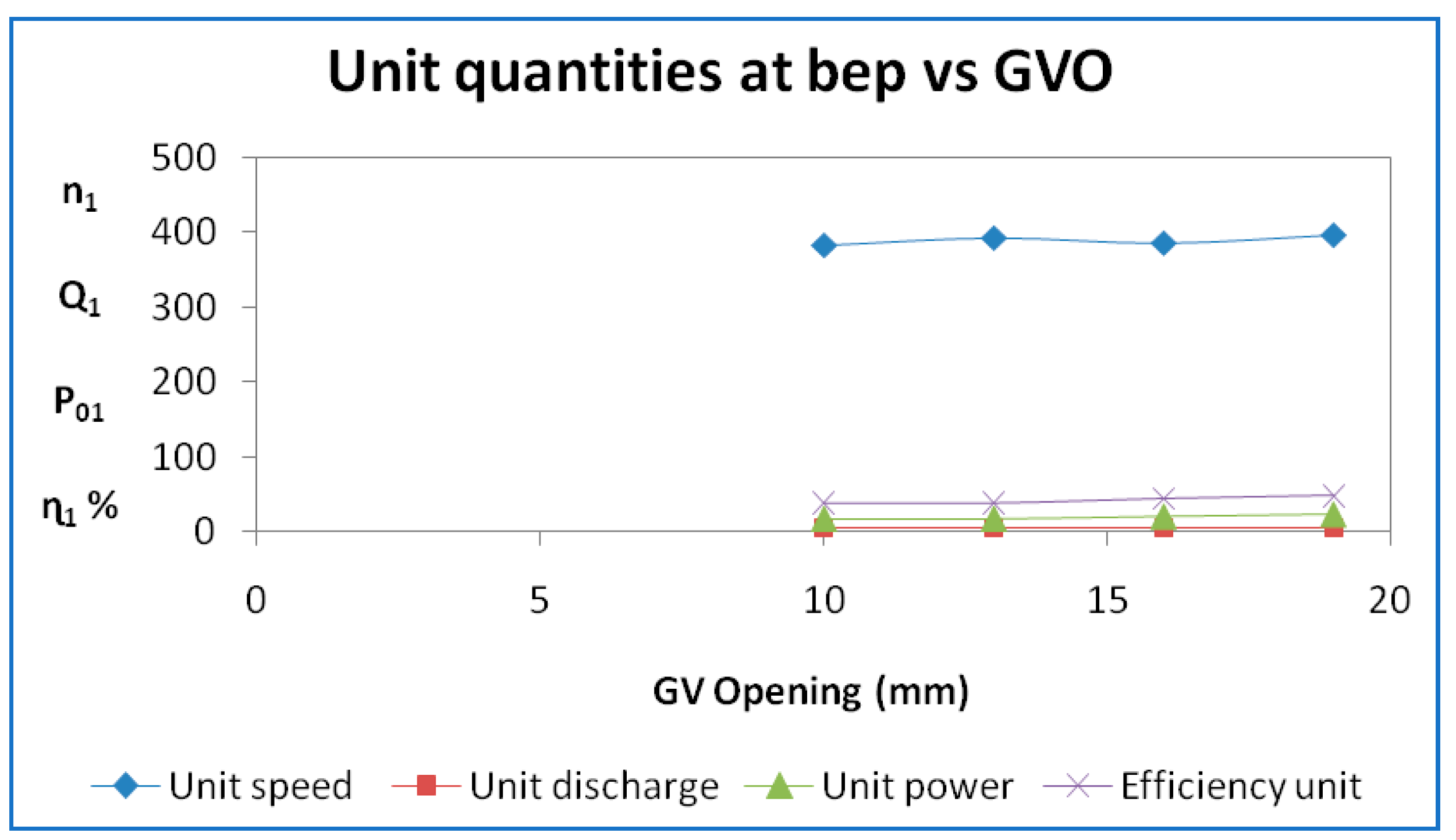
| S. No | Guide Vane Opening GVO (mm) | Speed N (rpm) | Discharge Q (lps) | Head Given to Turbine H (m) | Brake Output Power (W) | Power Input to the Turbine (W) | Efficiency (%) |
|---|---|---|---|---|---|---|---|
| 1 | 10 | 600 | 6.02 | 1.31 | 25.08 | 77.44 | 32.39 |
| 2 | 700 | 8.77 | 2.82 | 88.15 | 242.86 | 36.30 | |
| 3 | 1000 | 11.83 | 5.58 | 239.34 | 647.33 | 36.97 | |
| 4 | 1250 | 14.89 | 9.68 | 537.68 | 1414.14 | 38.02 | |
| 5 | 13 | 450 | 5.86 | 1.09 | 20.90 | 62.89 | 33.24 |
| 6 | 700 | 8.92 | 2.81 | 92.36 | 245.79 | 37.58 | |
| 7 | 950 | 11.06 | 5.39 | 236.09 | 584.55 | 40.39 | |
| 8 | 1300 | 15.14 | 9.61 | 558.15 | 1427.69 | 39.09 | |
| 9 | 16 | 450 | 5.47 | 1.14 | 20.57 | 61.33 | 33.54 |
| 10 | 650 | 8.49 | 2.47 | 78.64 | 205.51 | 38.27 | |
| 11 | 950 | 11.29 | 4.67 | 220.64 | 517.26 | 42.66 | |
| 12 | 1250 | 13.94 | 8.29 | 522.94 | 1134.04 | 46.11 | |
| 13 | 19 | 350 | 5.47 | 0.91 | 19.99 | 48.89 | 40.88 |
| 14 | 700 | 8.40 | 2.25 | 85.26 | 185.57 | 45.94 | |
| 15 | 900 | 11.38 | 4.19 | 209.13 | 468.15 | 44.67 | |
| 16 | 1250 | 13.55 | 7.84 | 524.00 | 1042.79 | 50.25 |
Publisher’s Note: MDPI stays neutral with regard to jurisdictional claims in published maps and institutional affiliations. |
© 2022 by the authors. Licensee MDPI, Basel, Switzerland. This article is an open access article distributed under the terms and conditions of the Creative Commons Attribution (CC BY) license (https://creativecommons.org/licenses/by/4.0/).
Share and Cite
Vijay Kumar, M.; Subba Reddy, T.; Sarala, P.; Varma, P.S.; Chandra Sekhar, O.; Babqi, A.; Alharbi, Y.; Alamri, B.; Reddy, C.R. Experimental Investigation and Performance Characteristics of Francis Turbine with Different Guide Vane Openings in Hydro Distributed Generation Power Plants. Energies 2022, 15, 6798. https://doi.org/10.3390/en15186798
Vijay Kumar M, Subba Reddy T, Sarala P, Varma PS, Chandra Sekhar O, Babqi A, Alharbi Y, Alamri B, Reddy CR. Experimental Investigation and Performance Characteristics of Francis Turbine with Different Guide Vane Openings in Hydro Distributed Generation Power Plants. Energies. 2022; 15(18):6798. https://doi.org/10.3390/en15186798
Chicago/Turabian StyleVijay Kumar, Megavath, T. Subba Reddy, P. Sarala, P. Srinivasa Varma, Obbu Chandra Sekhar, Abdulrahman Babqi, Yasser Alharbi, Basem Alamri, and Ch. Rami Reddy. 2022. "Experimental Investigation and Performance Characteristics of Francis Turbine with Different Guide Vane Openings in Hydro Distributed Generation Power Plants" Energies 15, no. 18: 6798. https://doi.org/10.3390/en15186798
APA StyleVijay Kumar, M., Subba Reddy, T., Sarala, P., Varma, P. S., Chandra Sekhar, O., Babqi, A., Alharbi, Y., Alamri, B., & Reddy, C. R. (2022). Experimental Investigation and Performance Characteristics of Francis Turbine with Different Guide Vane Openings in Hydro Distributed Generation Power Plants. Energies, 15(18), 6798. https://doi.org/10.3390/en15186798







